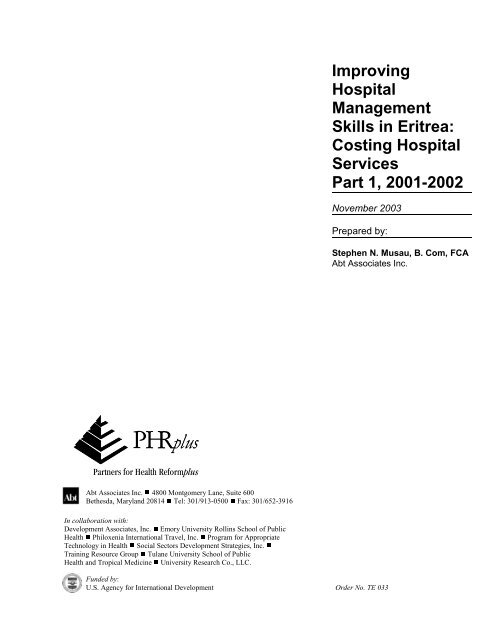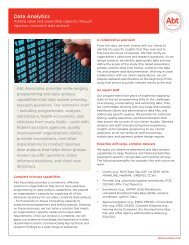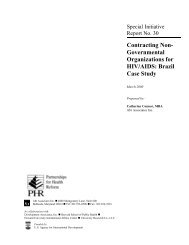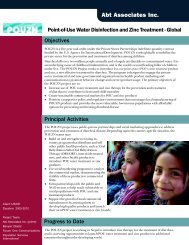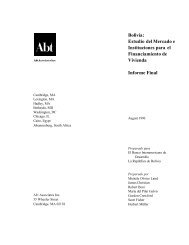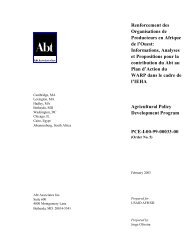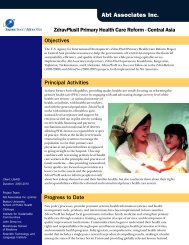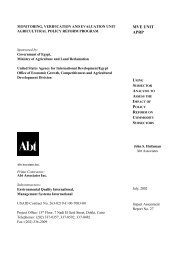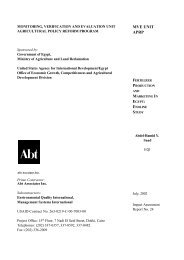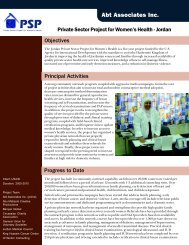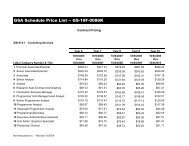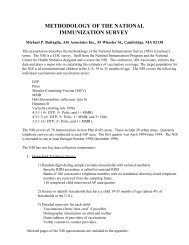Improving Hospital Management Skills in Eritrea ... - Abt Associates
Improving Hospital Management Skills in Eritrea ... - Abt Associates
Improving Hospital Management Skills in Eritrea ... - Abt Associates
Create successful ePaper yourself
Turn your PDF publications into a flip-book with our unique Google optimized e-Paper software.
<strong>Improv<strong>in</strong>g</strong><br />
<strong>Hospital</strong><br />
<strong>Management</strong><br />
<strong>Skills</strong> <strong>in</strong> <strong>Eritrea</strong>:<br />
Cost<strong>in</strong>g <strong>Hospital</strong><br />
Services<br />
Part 1, 2001-2002<br />
November 2003<br />
Prepared by:<br />
Stephen N. Musau, B. Com, FCA<br />
<strong>Abt</strong> <strong>Associates</strong> Inc.<br />
Partners for Health Reformplus<br />
<strong>Abt</strong> <strong>Associates</strong> Inc. 4800 Montgomery Lane, Suite 600<br />
Bethesda, Maryland 20814 Tel: 301/913-0500 Fax: 301/652-3916<br />
In collaboration with:<br />
Development <strong>Associates</strong>, Inc. Emory University Roll<strong>in</strong>s School of Public<br />
Health Philoxenia International Travel, Inc. Program for Appropriate<br />
Technology <strong>in</strong> Health Social Sectors Development Strategies, Inc. <br />
Tra<strong>in</strong><strong>in</strong>g Resource Group Tulane University School of Public<br />
Health and Tropical Medic<strong>in</strong>e University Research Co., LLC.<br />
Funded by:<br />
U.S. Agency for International Development Order No. TE 033
Mission<br />
Partners for Health Reformplus is USAID’s flagship project for health policy and health system<br />
strengthen<strong>in</strong>g <strong>in</strong> develop<strong>in</strong>g and transitional countries. The five-year project (2000-2005) builds on<br />
the predecessor Partnerships for Health Reform Project, cont<strong>in</strong>u<strong>in</strong>g PHR’s focus on health policy,<br />
f<strong>in</strong>anc<strong>in</strong>g, and organization, with new emphasis on community participation, <strong>in</strong>fectious disease<br />
surveillance, and <strong>in</strong>formation systems that support the management and delivery of appropriate<br />
health services. PHRplus will focus on the follow<strong>in</strong>g results:<br />
<br />
<br />
<br />
<br />
<br />
Implementation of appropriate health system reform.<br />
Generation of new f<strong>in</strong>anc<strong>in</strong>g for health care, as well as more effective use of exist<strong>in</strong>g funds.<br />
Design and implementation of health <strong>in</strong>formation systems for disease surveillance.<br />
Delivery of quality services by health workers.<br />
Availability and appropriate use of health commodities.<br />
This document was produced by PHRplus with fund<strong>in</strong>g from the US Agency for International Development<br />
(USAID) under Project No. 936-5974.13, Contract No. HRN-C-00-95-00024 and is <strong>in</strong> the public doma<strong>in</strong>. The<br />
ideas and op<strong>in</strong>ions on this document are the authors and do not necessarily reflect those of USAID or its<br />
employees. Interested parties may use the report <strong>in</strong> part or whole, provid<strong>in</strong>g they ma<strong>in</strong>ta<strong>in</strong> the <strong>in</strong>tegrity of<br />
the report and do not misrepresent its f<strong>in</strong>d<strong>in</strong>gs or present the work as their own. This and other HFS, PHR,<br />
and PHRplus documents can be viewed and downloaded on the project website, www.PHRplus.org.<br />
November 2003<br />
Recommended Citation<br />
Musau, Stephen N. November 2003. <strong>Improv<strong>in</strong>g</strong> <strong>Hospital</strong> <strong>Management</strong> <strong>Skills</strong> <strong>in</strong> <strong>Eritrea</strong>: Cost<strong>in</strong>g <strong>Hospital</strong> Services, Part 1, 2001-2002. Bethesda, MD:<br />
The Partners for Health Reformplus Project, <strong>Abt</strong> <strong>Associates</strong> Inc.<br />
For additional copies of this report, contact the PHRplus Resource Center at PHR-InfoCenter@abtassoc.com or visit<br />
our website at www.PHRplus.org.<br />
Contract/Project No.:<br />
Submitted to:<br />
and:<br />
HRN-C-00-00-00019-00<br />
L<strong>in</strong>da Lou Kelly,<br />
USAID/<strong>Eritrea</strong><br />
Karen Cavanaugh, CTO<br />
Health Systems Division<br />
Office of Health, Infectious Disease and Nutrition<br />
Center for Population, Health and Nutrition<br />
Bureau for Global Programs, Field Support and Research<br />
United States Agency for International Development
Abstract<br />
Information on the costs of provid<strong>in</strong>g health care services is critical <strong>in</strong> the decision-mak<strong>in</strong>g<br />
process of any m<strong>in</strong>istry of health. In many develop<strong>in</strong>g countries, such <strong>in</strong>formation is not readily<br />
available due to the <strong>in</strong>adequacy of the f<strong>in</strong>ancial <strong>in</strong>formation systems to rout<strong>in</strong>ely produce useful<br />
<strong>in</strong>formation. This is often coupled with a lack of skills to do ad hoc cost analyses that would help<br />
bridge this <strong>in</strong>formation gap. In a vicious circle, the demand for f<strong>in</strong>ancial <strong>in</strong>formation by health care<br />
managers is virtually non-existent, and this contributes to the paucity of such <strong>in</strong>formation s<strong>in</strong>ce those<br />
who should produce it are not under any pressure to do so.<br />
In contrast, the <strong>Eritrea</strong>n M<strong>in</strong>istry of Health has expressed the need for good f<strong>in</strong>ancial <strong>in</strong>formation<br />
<strong>in</strong> its efforts to reform the health sector. <strong>Hospital</strong>s consume a large portion of the resources available<br />
to the M<strong>in</strong>istry; thus, it is important to know how much it costs to provide hospital-based health care.<br />
This report describes the beg<strong>in</strong>n<strong>in</strong>g of a process to address this need. The cost<strong>in</strong>g work was carried<br />
out as part of a technical assistance package to develop hospital management skills of senior staff <strong>in</strong><br />
the M<strong>in</strong>istry headquarters and selected hospital and regional health management teams; the<br />
management skills targeted <strong>in</strong>clude f<strong>in</strong>ancial management skills. This cost<strong>in</strong>g report represents the<br />
first phase <strong>in</strong> the cost<strong>in</strong>g of health services <strong>in</strong> <strong>Eritrea</strong>.
Table of Contents<br />
Acronyms .............................................................................................................................................. xi<br />
Acknowledgments...............................................................................................................................xiii<br />
Executive Summary ............................................................................................................................. xv<br />
1. Introduction .................................................................................................................................... 1<br />
1.1 Background ........................................................................................................................... 1<br />
1.2 Health Sector F<strong>in</strong>anc<strong>in</strong>g........................................................................................................ 2<br />
1.3 Purpose of the Cost Analysis ................................................................................................ 2<br />
1.4 Organization of This Report.................................................................................................. 3<br />
2. Methodology .................................................................................................................................. 5<br />
2.1 <strong>Management</strong> Account<strong>in</strong>g System for <strong>Hospital</strong>s.................................................................... 5<br />
2.2 How Costs Were Accumulated ............................................................................................. 5<br />
2.3 Outputs.................................................................................................................................. 6<br />
2.4 Resources and Costs.............................................................................................................. 7<br />
2.4.1 Fixed and Variable Costs .............................................................................................. 7<br />
2.4.2 Human Resources.......................................................................................................... 7<br />
2.4.3 Fixed Assets (Capital Costs) ......................................................................................... 8<br />
3. Costs <strong>in</strong> Pilot <strong>Hospital</strong>s .................................................................................................................. 9<br />
3.1 Mekane Hiwet Pediatric <strong>Hospital</strong> ......................................................................................... 9<br />
3.1.1 Costs and Revenue ........................................................................................................ 9<br />
3.1.2 Unit Costs.................................................................................................................... 10<br />
3.2 Keren <strong>Hospital</strong> .................................................................................................................... 11<br />
3.2.1 Total Costs and User-fee Revenue .............................................................................. 11<br />
3.2.2 Costs by Cost Center................................................................................................... 12<br />
3.2.3 Unit Costs.................................................................................................................... 14<br />
3.2.3.1 Unit Costs for F<strong>in</strong>al Cost Centers.................................................................. 14<br />
3.2.3.2 Capital Costs ................................................................................................. 15<br />
3.3 Dekemhare <strong>Hospital</strong>............................................................................................................ 15<br />
3.3.1 Total Costs and User-fee Revenue .............................................................................. 15<br />
3.3.2 Costs by Cost Center................................................................................................... 16<br />
3.3.3 Unit Costs.................................................................................................................... 16<br />
4. Issues Aris<strong>in</strong>g from Cost Analysis ...............................................................................................19<br />
4.1 <strong>Hospital</strong> Operat<strong>in</strong>g Costs .................................................................................................... 19<br />
4.1.1 Account<strong>in</strong>g for <strong>Hospital</strong> Costs .................................................................................... 19<br />
Table of Contents<br />
vii
4.1.2 Budgetary Allocations................................................................................................. 19<br />
4.1.3 Operat<strong>in</strong>g Costs........................................................................................................... 19<br />
4.2 <strong>Hospital</strong> Performance Indicators......................................................................................... 20<br />
4.3 Capacity Utilization ............................................................................................................21<br />
4.4 Cost Efficiency.................................................................................................................... 22<br />
4.5 User-fee Revenue................................................................................................................23<br />
4.6 Exemption Policy................................................................................................................24<br />
4.7 <strong>Hospital</strong> <strong>Management</strong> Information ..................................................................................... 24<br />
4.7.1 Workload Data ............................................................................................................ 25<br />
4.7.2 F<strong>in</strong>ance Departments................................................................................................... 25<br />
4.8 Drugs and Medical Supplies ............................................................................................... 25<br />
4.9 Uses and Limitations of Unit Costs..................................................................................... 26<br />
4.9.1 Uses of Unit Costs....................................................................................................... 26<br />
4.9.2 Limitations of Unit Costs ............................................................................................ 27<br />
Annex A: <strong>Hospital</strong> Performance Indicators ......................................................................................... 29<br />
Annex B. Reference List...................................................................................................................... 31<br />
List of Tables<br />
Table ES1: Summary of Revenues and Expenditures, by <strong>Hospital</strong> .................................................... xvi<br />
Table ES2: Overall Unit Costs by <strong>Hospital</strong>, <strong>in</strong> Nakfa......................................................................... xvi<br />
Table ES3: Average-Length-of-Stay Comparisons............................................................................ xvii<br />
Table ES4: Per Unit Costs of Variable and Fixed Costs (<strong>in</strong> Nakfa) .................................................. xvii<br />
Table ES5: Drug Costs per Patient Day............................................................................................xviii<br />
Table 1: Overview of Pilot <strong>Hospital</strong>s..................................................................................................... 1<br />
Table 2: Allocation Bases ...................................................................................................................... 6<br />
Table 3: Total Costs and Patient Fee Revenue 2002, Pediatric Referral <strong>Hospital</strong>................................. 9<br />
Table 4: Pediatric <strong>Hospital</strong> Costs by Department (<strong>in</strong> Nakfa)............................................................... 10<br />
Table 5: Unit Costs by Cost Center...................................................................................................... 11<br />
Table 6: Inpatient Statistics.................................................................................................................. 11<br />
Table 7: Total Costs and Patient Fee Revenue 2001, Keren <strong>Hospital</strong> ................................................. 12<br />
Table 8: Costs Before Allocation of Intermediate Cost Centers.......................................................... 13<br />
Table 9: Total Costs by F<strong>in</strong>al Cost Center ........................................................................................... 13<br />
viii<br />
Table of Contents
Table 10: Unit Costs by F<strong>in</strong>al Cost Center .......................................................................................... 14<br />
Table 11: Bed Occupancy Rates .......................................................................................................... 14<br />
Table 12: Total Costs and Patient Fee Revenue Jan.-Sept. 2002, Dekemhare <strong>Hospital</strong> ...................... 15<br />
Table 13: Dekemhare <strong>Hospital</strong> Costs and User Fee Revenue (<strong>in</strong> Nakfa) ............................................ 16<br />
Table 14: Unit Costs by Cost Center.................................................................................................... 16<br />
Table 15: Inpatient Statistics................................................................................................................ 17<br />
Table 16: Revenue and Expenditure Statements.................................................................................. 20<br />
Table 17: Capacity Utilization ............................................................................................................. 22<br />
Table 18: Unit Cost Comparisons........................................................................................................ 22<br />
Table 19: User-fee Revenue................................................................................................................. 24<br />
Table 20: Drug Costs per Patient Day.................................................................................................. 26<br />
Table of Contents<br />
ix
Acronyms<br />
MCH<br />
MOF<br />
MOH<br />
OB/Gyn<br />
OPD<br />
PHRplus<br />
SEMISH<br />
USAID<br />
Maternal Child Health<br />
M<strong>in</strong>istry of F<strong>in</strong>ance<br />
M<strong>in</strong>istry of Health<br />
Obstetrics/Gynecology<br />
Outpatient Department<br />
Partners for Health Reformplus Project (USAID)<br />
State of <strong>Eritrea</strong> <strong>Management</strong> Information for Health<br />
United States Agency for International Development<br />
CURRENCY CONVERSION: 13.5 Nakfa = US$ 1.00<br />
Acronyms<br />
xi
Acknowledgments<br />
The author acknowledges with gratitude the valuable <strong>in</strong>put received from the <strong>Hospital</strong><br />
<strong>Management</strong> Teams of Mekane Hiwet Pediatric <strong>Hospital</strong>, Keren <strong>Hospital</strong>, and Dekemhare <strong>Hospital</strong>.<br />
He is particularly <strong>in</strong>debted to the hospital directors for their assistance <strong>in</strong> the collection of data,<br />
review of their hospital cost<strong>in</strong>g results, and helpful suggestions <strong>in</strong> the <strong>in</strong>terpretation of the results.<br />
The <strong>in</strong>sightful comments of the M<strong>in</strong>ister of Health and senior staff at the M<strong>in</strong>istry, as well as<br />
from L<strong>in</strong>da Lou Kelly, USAID/<strong>Eritrea</strong>, were greatly appreciated.<br />
This study was made possible with fund<strong>in</strong>g from USAID through the PHRplus project under<br />
contract number HRN-C-00-00-00019-00.<br />
Acknowledgments<br />
xiii
Executive Summary<br />
Introduction<br />
This cost analysis is part of the ongo<strong>in</strong>g technical assistance to the M<strong>in</strong>istry of Health (MOH),<br />
<strong>Eritrea</strong>, to strengthen f<strong>in</strong>ancial management systems at three pilot hospitals: Mekane Hiwet Pediatric<br />
<strong>Hospital</strong> (national referral hospital), Keren <strong>Hospital</strong> (regional), and Dekemhare <strong>Hospital</strong><br />
(community). The analysis provides needed <strong>in</strong>formation to the hospitals and the M<strong>in</strong>istry on the costs<br />
of provid<strong>in</strong>g hospital-based health care. By compar<strong>in</strong>g cost <strong>in</strong>formation from the three hospitals, it<br />
also provides <strong>in</strong>dications of cost efficiency <strong>in</strong> service delivery. Results of the study also were used <strong>in</strong><br />
f<strong>in</strong>ancial management tra<strong>in</strong><strong>in</strong>g given to members of the <strong>Hospital</strong> <strong>Management</strong> Teams and Zonal<br />
Health <strong>Management</strong> Teams.<br />
The analysis of hospital costs was designed to accumulate costs by hospital <strong>in</strong>patient and<br />
outpatient departments (also referred to as cost centers). The cost<strong>in</strong>g approach adopted is the “stepdown”<br />
approach whereby costs are allocated to cost centers start<strong>in</strong>g with each cost center’s direct<br />
costs and then allocat<strong>in</strong>g the <strong>in</strong>direct or overhead costs to make sure that each cost ultimately is borne<br />
by a f<strong>in</strong>al cost center.<br />
This report is part one of two parts; it conta<strong>in</strong>s the costs and activities for 2001 at Keren <strong>Hospital</strong><br />
and for 2002 at the Pediatric <strong>Hospital</strong> and Dekemhare <strong>Hospital</strong>. The second part will look at 2003<br />
costs and service data of the pilot hospitals.<br />
Summary of Cost<strong>in</strong>g Results<br />
The follow<strong>in</strong>g tables give a comparative summary of the cost<strong>in</strong>g results for the three pilot<br />
hospitals. All amounts are <strong>in</strong> Nakfa (Nk 13.5 = $).<br />
Costs and Revenues<br />
Table ES1 gives an overview of the revenues and expenditures of the three hospitals.<br />
Expenditures are presented as they appear <strong>in</strong> the annual reports of hospital f<strong>in</strong>ance departments<br />
except for the expenditures on drugs and medical supplies, which have been adjusted to reflect the<br />
cost of drugs and supplies issued to user departments. (The hospital account<strong>in</strong>g systems do not<br />
capture all the costs of drugs and medical supplies received <strong>in</strong> the hospitals.)<br />
The hospitals show a significant potential for user-fee f<strong>in</strong>anc<strong>in</strong>g of expenditures. The table<br />
shows that a significant level of cost recovery has been achieved despite the low fee levels and a<br />
liberal (and not well-controlled) system of grant<strong>in</strong>g free services to the poor.<br />
Executive Summary<br />
xv
EXPENDITURE<br />
Table ES1: Summary of Revenues and Expenditures, by <strong>Hospital</strong><br />
<strong>Hospital</strong> Name<br />
Mekane Hiwet<br />
Pediatric Hosp.<br />
Nakfa<br />
(Annual)<br />
2002<br />
%<br />
Keren <strong>Hospital</strong><br />
Nakfa<br />
(Annual)<br />
2001<br />
%<br />
Dekemhare<br />
<strong>Hospital</strong><br />
Nakfa<br />
(9 months)<br />
2002<br />
Salaries 2,732,087 44% 2,246,106 47% 1,078,100 48%<br />
Drugs and medical supplies 2,399,689 38% 1,405,155 30% 713,942 32%<br />
Food services 652,756 11% 438,000 9% 157,553 7%<br />
Electricity and water 128,873 2% 354,630 8% 23,550 1%<br />
Other <strong>in</strong>direct costs 324,332 5% 295,860 6% 279,400 12%<br />
Total expenditure 6,237,737 100% 4,739,751 100% 2,252,545 100%<br />
REVENUE (user fees)<br />
Pharmacy 85,485* 7.5% 627,639 67% 158,790 50%<br />
Treatment (all other patient fees) 1,047,947 92.5% 308,674 33% 158,283 50%<br />
Total user fee revenue 1,133,432 100% 936,313 100% 317,073 100%<br />
Net fund<strong>in</strong>g from M<strong>in</strong>istry of F<strong>in</strong>ance (5,104,305) (3,803,438) (1,935,472)<br />
Overall cost recovery 18% 20% 14%<br />
Cost recovery on non-wage<br />
expenditure<br />
32% 38% 27%<br />
* A misallocation of fees between pharmacy and treatment resulted <strong>in</strong> a very low amount be<strong>in</strong>g attributed to pharmacy. Pharmacy fees are also<br />
reduced by a hospital policy that all fee-pay<strong>in</strong>g outpatients should purchase their prescriptions from outside chemists.<br />
%<br />
Unit Costs by Cost Center<br />
Unit costs are derived from the total costs of service delivery <strong>in</strong> each department and the volume<br />
of output of that department. Table ES2 shows overall <strong>in</strong>patient and outpatient unit costs <strong>in</strong> each pilot<br />
hospital.<br />
It is important to recognize that these costs only show the situation at the current level of quality<br />
of health care. The numbers will change <strong>in</strong> the future to reflect quality improvements <strong>in</strong> staff<strong>in</strong>g and<br />
<strong>in</strong> other resource <strong>in</strong>puts such as drugs and medical supplies. This will give the MOH an idea what it<br />
should cost to provide services at specified levels of quality, and help it to do f<strong>in</strong>ancial plann<strong>in</strong>g for<br />
the hospitals.<br />
Table ES2: Overall Unit Costs by <strong>Hospital</strong>, <strong>in</strong> Nakfa<br />
Pediatric <strong>Hospital</strong> Keren <strong>Hospital</strong> Dekemhare <strong>Hospital</strong><br />
Service<br />
Output<br />
(Visits,<br />
Bed<br />
days)<br />
Cost<br />
per<br />
Unit<br />
Bed<br />
Occ.<br />
%<br />
Output<br />
(Visits,<br />
Bed<br />
days)<br />
Cost<br />
per<br />
Unit<br />
Bed<br />
Occ.<br />
%<br />
Output<br />
(Visits,<br />
Bed<br />
days)<br />
Cost<br />
per<br />
Unit<br />
Bed<br />
Occ.<br />
%<br />
Outpatient services 30,830 46.5 36,402 44.6 16,337 71.5<br />
Inpatient services 54,788 91.3 79% 46,216 67.4 70% 6,122 177 37%<br />
xvi <strong>Improv<strong>in</strong>g</strong> <strong>Hospital</strong> <strong>Management</strong> <strong>Skills</strong> <strong>in</strong> <strong>Eritrea</strong>: Cost<strong>in</strong>g <strong>Hospital</strong> Services, Part 1, 2001-2002
The unit costs for Dekemhare <strong>Hospital</strong> are higher compared to the other two hospitals. This is<br />
partly expla<strong>in</strong>ed by its low volume of services. The hospital is just over two years old and was<br />
upgraded from a health center. Occupancy rates are very low as are outpatient volumes compared to<br />
the hospital’s level of staff<strong>in</strong>g and other overheads. Dekemhare normally refers complex <strong>in</strong>patient<br />
cases to Asmara, and this contributes to its lower average lengths of stay. Keren <strong>Hospital</strong> and the<br />
Pediatric <strong>Hospital</strong> do not refer to any other <strong>in</strong>stitution for <strong>in</strong>patient care and therefore their bed<br />
occupancy is higher as is their average lengths of stay (Table ES3).<br />
Table ES3: Average-Length-of-Stay Comparisons<br />
Ward Type Pediatric <strong>Hospital</strong> Keren <strong>Hospital</strong> Dekemhare <strong>Hospital</strong><br />
Obstetrics/Gynecology N/A 2.4 2.2<br />
Medical N/A 6.5 4.9<br />
Surgical 7.2 12.2 5.9<br />
Pediatric* 9.6 6.5 N/A<br />
* The Mekane Hiwet Pediatric <strong>Hospital</strong> has four pediatric wards – Neonatal (0–1 month), Ward A (1–12 months), Ward B (1–5 years), Ward C (5–14<br />
years) – and one surgical ward( Ward F).<br />
A closer look at the composition of the unit costs reveals other variations that will be discussed<br />
with hospital management as data are ref<strong>in</strong>ed and areas of improvement <strong>in</strong> cost management<br />
identified. Table ES4 breaks the above unit costs <strong>in</strong>to their variable (drugs, food, and other supplies)<br />
and fixed (staff and adm<strong>in</strong>istrative overheads) components.<br />
Cost Type<br />
Variable costs per unit<br />
(drugs, food etc)<br />
Fixed costs per unit<br />
(salaries, etc.)<br />
Table ES4: Per Unit Costs of Variable and Fixed Costs (<strong>in</strong> Nakfa)<br />
Pediatric <strong>Hospital</strong> Keren <strong>Hospital</strong> Dekemhare <strong>Hospital</strong><br />
Outpatient Inpatient Outpatient Inpatient Outpatient Inpatient<br />
19.5 44.2 19.7 24.4 34.5 50.4<br />
27.0 47.1 24.9 43.0 37.0 126.6<br />
Total 46.6 91.3 44.6 67.4 71.5 177.0<br />
Although the Pediatric <strong>Hospital</strong> has the best capacity utilization of the three hospitals, its unit<br />
costs are higher than those of Keren <strong>Hospital</strong>. Reasons for this may <strong>in</strong>clude:<br />
<br />
<br />
Staff costs are about 22 percent higher <strong>in</strong> the Pediatric <strong>Hospital</strong> than <strong>in</strong> Keren, though Keren<br />
has a larger staff – 12 doctors and 81 nurses, compared to 11 doctors and 74 nurses for the<br />
Pediatric <strong>Hospital</strong>. The Pediatric <strong>Hospital</strong> is <strong>in</strong> the capital city, Asmara, where costs are<br />
higher, and employs more cl<strong>in</strong>ical specialists as well as better-qualified adm<strong>in</strong>istrative staff.<br />
The major <strong>in</strong>patient variable costs, drugs/supplies and food, are much higher per day <strong>in</strong> the<br />
Pediatric <strong>Hospital</strong> than <strong>in</strong> Keren. Food is 49 percent higher, and drugs are 70 percent higher.<br />
Such differences may result from case mix, <strong>in</strong>efficiency, and other losses and waste.<br />
Drug costs per patient day (see Table ES5) display such variation that more work is needed to<br />
verify the reasons. While case mix will play a role <strong>in</strong> this variation, it does not expla<strong>in</strong> why the<br />
smallest hospital uses nearly two times more drugs per patient day than the national referral hospital<br />
Executive Summary<br />
xvii
and three times more than the regional hospital. The poor record<strong>in</strong>g of drugs issued to departments<br />
may partly expla<strong>in</strong> this anomaly, as the figure could well <strong>in</strong>clude some medical equipment.<br />
Table ES5: Drug Costs per Patient Day<br />
Pediatric <strong>Hospital</strong> Keren <strong>Hospital</strong> Dekemhare <strong>Hospital</strong><br />
Total cost of drugs 2,399,689 1,405,155 713,942<br />
No. of patient days 60,954 53,496 9,389<br />
Drug cost per patient day 39.4 26.3 76.0<br />
Capital Costs<br />
The costs shown above do not <strong>in</strong>clude capital costs, e.g., depreciation of equipment, vehicles,<br />
and build<strong>in</strong>gs, as this <strong>in</strong>formation was not readily available.<br />
Uses of Cost Analysis<br />
The cost analysis of the three hospitals provides useful <strong>in</strong>formation to the MOH and the hospital<br />
management teams <strong>in</strong> a variety of areas:<br />
<br />
<br />
<br />
<br />
<br />
<br />
<br />
Budget<strong>in</strong>g: as hospitals start to prepare their budgets for the com<strong>in</strong>g fiscal year, they will<br />
use the new <strong>in</strong>formation to make better estimates of their fund<strong>in</strong>g needs. This <strong>in</strong>formation<br />
should also be used to negotiate more reasonable budget allocations with the MOH and<br />
M<strong>in</strong>istry of F<strong>in</strong>ance (MOF).<br />
Cost Control: the hospital management teams should look at the unit costs of outputs <strong>in</strong><br />
each area of the hospital and ask themselves the follow<strong>in</strong>g questions: Why are the costs at<br />
the level that they are Is it possible to produce services more cost efficiently<br />
Tra<strong>in</strong><strong>in</strong>g: cost analysis results will cont<strong>in</strong>ue to be used <strong>in</strong> the ongo<strong>in</strong>g tra<strong>in</strong><strong>in</strong>g on f<strong>in</strong>ancial<br />
management. Tra<strong>in</strong><strong>in</strong>gs will focus on improv<strong>in</strong>g management use of this <strong>in</strong>formation to<br />
deliver services more cost efficiently.<br />
Quality of care: cost <strong>in</strong>formation alone does not allow for conclusive judgments about the<br />
hospital operations; quality of care be<strong>in</strong>g delivered at each hospital must also be known.<br />
Cost<strong>in</strong>g results should be <strong>in</strong>terpreted with care and, where possible, l<strong>in</strong>ked to the quality<br />
assurance work go<strong>in</strong>g on at these hospitals.<br />
Plann<strong>in</strong>g: the MOH should beg<strong>in</strong> to get a picture of what it costs, at current levels of<br />
quality, to provide hospital-based care. This <strong>in</strong>formation should feed <strong>in</strong>to the plann<strong>in</strong>g of<br />
resource allocations to hospitals, after adjustment for any obvious <strong>in</strong>efficiencies.<br />
Efficiency <strong>in</strong> the provision of services can be monitored by compar<strong>in</strong>g the unit costs of<br />
different departments over a period of time. Comparisons can also be made with other<br />
hospitals. <strong>Improv<strong>in</strong>g</strong> the cost efficiency of hospitals is a critical <strong>in</strong>gredient <strong>in</strong> the overall<br />
f<strong>in</strong>anc<strong>in</strong>g of health care <strong>in</strong> the country; more efficient hospitals make it possible for more<br />
resources to be made available for much-needed primary health care.<br />
Unit costs can be useful <strong>in</strong> decisions on sett<strong>in</strong>g of fee levels. Even though the MOH does not<br />
emphasize cost recovery, the unit cost <strong>in</strong>formation can give an <strong>in</strong>dication of the levels of<br />
subsidy for different services.<br />
xviii <strong>Improv<strong>in</strong>g</strong> <strong>Hospital</strong> <strong>Management</strong> <strong>Skills</strong> <strong>in</strong> <strong>Eritrea</strong>: Cost<strong>in</strong>g <strong>Hospital</strong> Services, Part 1, 2001-2002
The process of analyz<strong>in</strong>g costs by department can give managers a good idea about how<br />
their hospital is organized from a cost po<strong>in</strong>t of view and can help them to beg<strong>in</strong> to place<br />
responsibility for costs and revenues on the heads (managers) of each cost center. This is a<br />
major step towards improv<strong>in</strong>g a hospital’s cost efficiency.<br />
Issues Aris<strong>in</strong>g from Cost Analysis<br />
<br />
<br />
<br />
<br />
<strong>Hospital</strong> <strong>Management</strong> Information: The management <strong>in</strong>formation systems <strong>in</strong> the pilot<br />
hospitals are typical of MOH hospitals <strong>in</strong> <strong>Eritrea</strong>. Most data collected are used to prepare<br />
reports for external (MOH or MOF) consumption. It appears that hospital management uses<br />
little of the <strong>in</strong>formation for decision mak<strong>in</strong>g.<br />
Workload data: Workload data are collected regularly and submitted to SEMISH (State of<br />
<strong>Eritrea</strong> <strong>Management</strong> Information for Health) on a monthly basis. No feedback is received<br />
from SEMISH and it is unclear who makes use of these data. Some of the data that is critical<br />
for hospital management is not required by SEMISH, for example, <strong>in</strong>patient workload by<br />
patient days, admissions and discharges.<br />
Account<strong>in</strong>g systems: The account<strong>in</strong>g system does not accurately capture all recurrent costs,<br />
particularly drugs and medical supplies. In order for the f<strong>in</strong>ance department to be a useful<br />
source of <strong>in</strong>formation to management, it is important that all costs are accounted for.<br />
Drugs and medical supplies: Data on the use of drugs and medical supplies were not<br />
readily available. This is the second most important cost item <strong>in</strong> the hospital after staff costs.<br />
It is important therefore that there be a system that can adequately track the issue of medical<br />
supplies from the pharmacy to the user departments, especially the wards. Drugs are closely<br />
monitored <strong>in</strong> the outpatient pharmacy and adequate records kept and reports prepared.<br />
Similarly, it is important to establish systems with<strong>in</strong> the user departments themselves to<br />
ensure that, where possible, there is a l<strong>in</strong>k to patient records<br />
Executive Summary<br />
xix
1. Introduction<br />
1.1 Background<br />
The Partners for Health Reformplus (PHRplus) project is provid<strong>in</strong>g technical assistance <strong>in</strong><br />
hospital reform to the M<strong>in</strong>istry of Health (MOH) of <strong>Eritrea</strong>. A part of this technical assistance is the<br />
strengthen<strong>in</strong>g of the f<strong>in</strong>ancial management systems <strong>in</strong> hospitals at the three levels of the referral<br />
cha<strong>in</strong>: community, regional, and national. Three pilot hospitals, one at each level, were selected for<br />
management strengthen<strong>in</strong>g. Various aspects of f<strong>in</strong>ancial management are be<strong>in</strong>g addressed, <strong>in</strong>clud<strong>in</strong>g<br />
basic tra<strong>in</strong><strong>in</strong>g on hospital management and strengthen<strong>in</strong>g of f<strong>in</strong>ancial <strong>in</strong>formation systems and<br />
<strong>in</strong>ternal controls to improve revenue collection and improve cost efficiency and control.<br />
The health system is organized <strong>in</strong>to three levels: primary, regional, and national referral. The<br />
primary level comprises health stations, health centers, and community hospitals. There are six<br />
regions (zobas) <strong>in</strong> <strong>Eritrea</strong>, each served by a regional hospital. The national referral hospitals are based<br />
<strong>in</strong> the capital city, Asmara.<br />
The three hospitals <strong>in</strong>cluded <strong>in</strong> this cost<strong>in</strong>g work were the Mekane Hiwet Pediatric <strong>Hospital</strong><br />
(national referral hospital), Keren <strong>Hospital</strong> (regional), and Dekemhare <strong>Hospital</strong> (community). Table 1<br />
gives a brief overview of each.<br />
Table 1: Overview of Pilot <strong>Hospital</strong>s<br />
Mekane Hiwet Pediatric<br />
(National)<br />
Keren<br />
(Regional)<br />
Dekemhare<br />
(Community)<br />
Location of hospital National capital Regional capital Small town<br />
Number of beds 191 182 60<br />
Occupied bed days 54,788 46,216 6,122<br />
Bed occupancy rates 79% 70% 28%<br />
Outpatient visits 26,487 36,402 16,337<br />
Total number of staff 184 193 90<br />
Number of doctors 11 12 4 (+ 1 visit<strong>in</strong>g surgeon)<br />
Number of nurses 74 81 34<br />
* A surgeon visits the hospital twice a week.<br />
1. Introduction 1
1.2 Health Sector F<strong>in</strong>anc<strong>in</strong>g<br />
Current public health sector expenditures are estimated to be 2.9 percent of GDP (World Bank<br />
2002); however, total health spend<strong>in</strong>g is unknown. The <strong>Eritrea</strong> Household Health Status, Utilization<br />
and Expenditure Survey (EHHSUES) was conducted <strong>in</strong> two of the six zobas <strong>in</strong> 1997, but was<br />
<strong>in</strong>terrupted by the border conflict with Ethiopia <strong>in</strong> 1998. The EHHSUES was resumed and completed<br />
<strong>in</strong> 2002 (<strong>in</strong>clud<strong>in</strong>g new surveys <strong>in</strong> the two zobas done <strong>in</strong> 1997).<br />
The MOH <strong>in</strong>troduced cost shar<strong>in</strong>g <strong>in</strong> 1996 <strong>in</strong> health facilities <strong>in</strong> the form of user fees for<br />
registration, diagnostic services (laboratory and x-ray), and the purchase cost of drugs. The user-fee<br />
policy was supposed to have been reviewed <strong>in</strong> 1998 but had to be put on hold due to the border<br />
conflict with Ethiopia. There is an exemption policy for the <strong>in</strong>digent and this is adm<strong>in</strong>istered by the<br />
M<strong>in</strong>istry of Local Government; patients are given a “Poverty Certificate” which entitles them to free<br />
care on presentation at the hospital. The exemption system is prone to abuse and discussions are<br />
go<strong>in</strong>g on to try to improve it.<br />
All revenue generated by the hospital through user fees is remitted to the M<strong>in</strong>istry of F<strong>in</strong>ance<br />
(MOF). There are proposals for some of this revenue to be reta<strong>in</strong>ed at the hospitals but a decision has<br />
not been made yet. Part of the work that PHRplus is do<strong>in</strong>g <strong>in</strong> the hospital reforms is to strengthen<br />
f<strong>in</strong>ancial management systems <strong>in</strong> hospitals so that, when a decision is made to give them greater<br />
autonomy (<strong>in</strong>clud<strong>in</strong>g the retention of user fee revenue), they will already have sound systems that<br />
enable them to control and utilize such revenue effectively.<br />
1.3 Purpose of the Cost Analysis<br />
The purpose of this cost analysis is to provide much needed <strong>in</strong>formation to the hospitals and the<br />
M<strong>in</strong>istry of Health on the costs of provid<strong>in</strong>g hospital-based care. In particular:<br />
<br />
<br />
<br />
<br />
The results show what it costs to provide the present level of quality of health care at the<br />
three pilot hospitals. This <strong>in</strong>formation can be extrapolated to look at other hospitals of<br />
similar size and case mix.<br />
Compar<strong>in</strong>g the results of the three hospitals <strong>in</strong>dicates cost efficiency variations from hospital<br />
to hospital.<br />
At a later stage, the unit costs calculated <strong>in</strong> this analysis can be adjusted to provide<br />
<strong>in</strong>formation on how much it would cost to provide services at different levels of quality. For<br />
example, adjustments can be made to the staff<strong>in</strong>g levels and other variables to show decision<br />
makers the potential cost impacts of the various scenarios. These options will have greater<br />
relevance to the MOH than to the hospital and will be taken up at that level.<br />
All the above uses are also necessary components of any budgetary allocation system that<br />
wants to look at the actual costs of deliver<strong>in</strong>g health care and particularly if cost efficiency<br />
measures are to be built <strong>in</strong>to the calculation of what a hospital gets from Treasury.<br />
2 <strong>Improv<strong>in</strong>g</strong> <strong>Hospital</strong> <strong>Management</strong> <strong>Skills</strong> <strong>in</strong> <strong>Eritrea</strong>: Cost<strong>in</strong>g <strong>Hospital</strong> Services, Part 1, 2001-2002
1.4 Organization of This Report<br />
The rest of this report is organized as follows: Chapter 2 presents the overall methodology,<br />
followed by the cost analysis reports for each of the three pilot hospitals <strong>in</strong> Chapter 3. Chapter 4<br />
discusses the f<strong>in</strong>d<strong>in</strong>gs from a broader perspective, <strong>in</strong>clud<strong>in</strong>g the key data collection issues<br />
encountered.<br />
This report is part one of two parts; it conta<strong>in</strong>s the costs and activities for 2001 of Keren <strong>Hospital</strong><br />
and 2002 of the Pediatric <strong>Hospital</strong> and Dekemhare <strong>Hospital</strong>. The second part will look at 2003 costs<br />
and service data.<br />
1. Introduction 3
2. Methodology<br />
2.1 <strong>Management</strong> Account<strong>in</strong>g System for <strong>Hospital</strong>s<br />
The cost analysis was conducted us<strong>in</strong>g methodology that has been developed by PHRplus for<br />
health care cost<strong>in</strong>g. This cost<strong>in</strong>g tool, “<strong>Management</strong> Account<strong>in</strong>g System for <strong>Hospital</strong>s” (MASH) is<br />
developed <strong>in</strong> an Excel workbook with l<strong>in</strong>ked worksheets and is adaptable to <strong>in</strong>dividual hospitals. It is<br />
designed to provide cost <strong>in</strong>formation <strong>in</strong> sufficient detail to enable managers to identify the total cost<br />
of operat<strong>in</strong>g each department (or “cost center”) with<strong>in</strong> the hospital, as well as the average cost of the<br />
services produced by each department.<br />
The analysis of hospital costs was designed to accumulate costs by department or cost center.<br />
Cost centers used <strong>in</strong> the analysis were of three types: adm<strong>in</strong>istrative (to accumulate adm<strong>in</strong>istrative<br />
costs that are then shared out among the patient-related cost centers); f<strong>in</strong>al (medical departments that<br />
provide “f<strong>in</strong>al” services directly to patients, e.g., wards, outpatient cl<strong>in</strong>ics); and <strong>in</strong>termediate (those<br />
that provide support, e.g., diagnostic services, to the f<strong>in</strong>al cost centers). The “step-down” approach is<br />
used, whereby costs are allocated to cost centers start<strong>in</strong>g with each cost center’s direct costs and then<br />
allocat<strong>in</strong>g the <strong>in</strong>direct or overhead costs, mak<strong>in</strong>g sure that each cost ultimately is borne by a f<strong>in</strong>al cost<br />
center.<br />
2.2 How Costs Were Accumulated<br />
The accumulation of costs by department, or cost center, was achieved by first charg<strong>in</strong>g each<br />
cost center with all its direct costs. Direct costs are those that can be directly identified with or traced<br />
to a cost center. For example, the salary cost of a laboratory technician is a direct cost of the<br />
laboratory. The drugs consumed <strong>in</strong> a ward are a direct cost of that ward. Because the hospitals <strong>in</strong> the<br />
study do not keep f<strong>in</strong>ancial records that are detailed enough to enable the study team to do this<br />
perfectly, the team had to estimate some costs. The two largest direct cost categories are medical<br />
supplies and staff:<br />
<br />
Drugs and medical supplies: The hospital pharmacies provided details of the consumption of<br />
drugs and medical supplies for a sample period of one month (<strong>in</strong> Dekemhare and Keren<br />
<strong>Hospital</strong>s), and six months (Pediatric <strong>Hospital</strong>). (The outpatient pharmacy <strong>in</strong> Keren was<br />
additionally able to provide the annual cost of drugs dispensed to outpatients.) On the basis<br />
of this <strong>in</strong>formation, the annual consumption of drugs was allocated to each cost center <strong>in</strong><br />
proportion to its consumption dur<strong>in</strong>g that one month. A problem that arose <strong>in</strong> us<strong>in</strong>g the data<br />
generated this way was that, dur<strong>in</strong>g this month, very little consumption was recorded for the<br />
X-ray department. The prelim<strong>in</strong>ary allocation of medical supplies consumption was<br />
therefore understated and will be corrected once the pharmacy store f<strong>in</strong>alizes a more detailed<br />
analysis of consumption. This is one area that the hospital will need to work on to improve<br />
the track<strong>in</strong>g of drug consumption.<br />
2. Methodology 5
Staff costs: The total staff costs (basic salaries and benefits) were allocated to cost centers<br />
based on the basic salaries of staff work<strong>in</strong>g <strong>in</strong> each cost center. It was assumed that the<br />
benefits would be <strong>in</strong> direct proportion to the basic salaries. Data for this purpose were<br />
obta<strong>in</strong>ed from the personnel department (list of all staff and their designation); the matron<br />
(work schedules for nurs<strong>in</strong>g staff), and the medical director (work schedules for doctors).<br />
After the allocation of all direct costs was completed, <strong>in</strong>direct costs were allocated. Indirect costs<br />
are those that cannot be directly traced to or associated with a particular cost center or product. For<br />
example, the salary of the telephone operator cannot be directly attributed to any cost center, though<br />
all cost centers benefit from the services of the telephone operator. Therefore, <strong>in</strong>direct costs were<br />
allocated to cost centers on bases that proximate the closest relationship between the cost and the<br />
service. This process is, at best, an estimate. However, it is important to bear <strong>in</strong> m<strong>in</strong>d that <strong>in</strong>direct<br />
costs are a much smaller percentage of total costs than are the more straightforward direct costs – <strong>in</strong><br />
this study, direct costs allocated for between 86 percent and 93 percent of the total hospital costs.<br />
The allocation bases used (also referred to as allocation statistics, apportionment statistics, or<br />
cost-drivers) are shown <strong>in</strong> Table 2. When no good allocation base existed, the study used the<br />
proportion of each cost center’s direct costs to the total direct costs as the allocation base. In this<br />
sense, direct costs serve as the “last resort” allocation variable.<br />
Table 2: Allocation Bases<br />
Indirect costs<br />
Heat<br />
Electricity<br />
Water<br />
Build<strong>in</strong>g ma<strong>in</strong>tenance<br />
Clean<strong>in</strong>g<br />
Other adm<strong>in</strong>istration costs – <strong>in</strong>clud<strong>in</strong>g transport,<br />
telephone<br />
Space<br />
Space<br />
Space<br />
Space<br />
Space<br />
Direct costs<br />
Allocation statistics<br />
The total cost of each cost center is the sum of the direct and <strong>in</strong>direct costs.<br />
2.3 Outputs<br />
In order to compute average costs (also called unit costs), each cost center’s output had to be<br />
def<strong>in</strong>ed. This output becomes the object for the cost<strong>in</strong>g exercise.<br />
Outpatient care cost centers: the unit of output was an outpatient visit. The number of visits<br />
reflects the workload of patients treated <strong>in</strong> the outpatient department and serves as a useful def<strong>in</strong>ition<br />
of the “product” of the outpatient department. These data were available for most departments. Where<br />
data were not reported, they were extracted from the patient registers.<br />
Inpatient care cost centers: Two units of output were used to reflect the volume of <strong>in</strong>patient<br />
services – the number of patients discharged and the number of patient days. Data on <strong>in</strong>patient care<br />
were available from matrons; the SEMISH (State of <strong>Eritrea</strong> <strong>Management</strong> Information for Health)<br />
does not require data on <strong>in</strong>patient days, admissions, and discharges <strong>in</strong> the format that is needed for<br />
cost analysis.<br />
6 <strong>Improv<strong>in</strong>g</strong> <strong>Hospital</strong> <strong>Management</strong> <strong>Skills</strong> <strong>in</strong> <strong>Eritrea</strong>: Cost<strong>in</strong>g <strong>Hospital</strong> Services, Part 1, 2001-2002
2.4 Resources and Costs<br />
Understand<strong>in</strong>g the nature of the resources used <strong>in</strong> the hospital and how they are related to the<br />
outputs/services is key to the cost<strong>in</strong>g exercise. For example, various resources (staff, drugs, light,<br />
food, adm<strong>in</strong>istrative support, etc.) are required to provide service to an <strong>in</strong>patient each day (a patient<br />
day); a cost is associated with each resource. In other words, the cost of provid<strong>in</strong>g a service is driven<br />
by the resources required to produce that service.<br />
The resources used are usually <strong>in</strong> the control of a variety of hospital staff. For example, the<br />
resources used up by a patient <strong>in</strong> the ward will be <strong>in</strong>fluenced by the doctor (who sees the patient,<br />
prescribes medication, and decides how long to keep the patient <strong>in</strong> the hospital); the head nurse (who<br />
<strong>in</strong>fluences the use of non-pharmaceutical supplies); the head of the kitchen (who oversees the<br />
quantity, quality, and cost of the food that is served).<br />
In order for a hospital to be cost efficient, all the staff who <strong>in</strong>fluence costs must make sure that<br />
services consume only the resources needed to achieve the desired quality of services provided. Costs<br />
do not exist on their own; they are <strong>in</strong>curred as a result of somebody’s decision.<br />
2.4.1 Fixed and Variable Costs<br />
Some resource costs are fixed; others are variable. The dist<strong>in</strong>ction between fixed and variable<br />
costs is one of behavior <strong>in</strong> how they respond to changes <strong>in</strong> the volume of activity. Fixed costs tend to<br />
rema<strong>in</strong> constant even when the volume of activity changes. For example, the number of staff<br />
employed <strong>in</strong> the hospital rema<strong>in</strong>s constant even though the volume of patients varies from one day to<br />
another. If there is a long-term change <strong>in</strong> volume, these fixed costs may also change to respond to the<br />
new level of activity; they would then rema<strong>in</strong> constant for some length of time. Variable costs change<br />
<strong>in</strong> response to the volume of activity. Examples <strong>in</strong>clude the consumption of pharmaceuticals and<br />
food; these can be expected to vary with the volume of patients.<br />
The cost analysis provides results <strong>in</strong> unit costs and further breaks these <strong>in</strong>to their variable and<br />
fixed components. This level of detail is important particularly <strong>in</strong> budget<strong>in</strong>g; variable costs can be<br />
projected on the basis of volume while the fixed costs can be expected to rema<strong>in</strong> constant over the<br />
budget period.<br />
2.4.2 Human Resources<br />
<strong>Hospital</strong> staff is one of the most important and expensive resources, account<strong>in</strong>g for between 44<br />
percent and 48 percent of total expenditure <strong>in</strong> the pilot hospitals. In Keren <strong>Hospital</strong>, staff costs<br />
account for 47 percent of the total expenditure. The hospital staff can be grouped <strong>in</strong>to two broad<br />
categories: cl<strong>in</strong>ical and non-cl<strong>in</strong>ical. Cl<strong>in</strong>ical staff <strong>in</strong>cludes doctors, dentists, and nurses. The cost of<br />
cl<strong>in</strong>ical staff is allocated to the departments where they work. Information on workstations and<br />
schedules was obta<strong>in</strong>ed from the matron (for nurses), the medical director (for doctors), and the<br />
personnel officer provided a list of all staff and their designation.<br />
Where the work of staff spans more than one department, their cost was allocated on the basis of<br />
estimates (through <strong>in</strong>terviews) of the amount of time they normally spend <strong>in</strong> each area.<br />
Non-cl<strong>in</strong>ical staff are subdivided <strong>in</strong>to <strong>in</strong>ternal (department level) and external (facility level).<br />
The department level (<strong>in</strong>ternal) non-cl<strong>in</strong>ical staff <strong>in</strong>cludes primarily cleaners. External non-cl<strong>in</strong>ical<br />
2. Methodology 7
staff comprises the adm<strong>in</strong>istrative staff (f<strong>in</strong>ance, personnel, etc.) and other support functions (kitchen,<br />
laundry, etc.).<br />
2.4.3 Fixed Assets (Capital Costs)<br />
Fixed assets are the durable assets <strong>in</strong> use <strong>in</strong> the hospital, such as equipment, vehicles, and<br />
build<strong>in</strong>gs. The cost of these resources was not <strong>in</strong>cluded <strong>in</strong> the analysis due to lack of data on costs. In<br />
<strong>Eritrea</strong>, hospital account<strong>in</strong>g systems (<strong>in</strong> common with most public account<strong>in</strong>g systems) do not<br />
capitalize fixed assets. Information on their costs is also not readily available. The failure to <strong>in</strong>clude<br />
capital costs <strong>in</strong> the cost analysis underestimates the cost of provid<strong>in</strong>g health care and gives an<br />
<strong>in</strong>correct report on cost recovery. The imprecision will be more pronounced <strong>in</strong> departments that are<br />
capital <strong>in</strong>tensive, such as X-ray, which use expensive equipment, compared to those that are less<br />
capital <strong>in</strong>tensive, such as outpatient visits.<br />
It is important to <strong>in</strong>clude capital costs <strong>in</strong> order to get an accurate view of the cost of all resources<br />
used <strong>in</strong> produc<strong>in</strong>g health services. This issue will be addressed <strong>in</strong> the next round of hospital cost<strong>in</strong>g.<br />
The improvement of f<strong>in</strong>ancial management systems that is currently underway will also address the<br />
proper treatment of capital items <strong>in</strong> hospital account<strong>in</strong>g records so that management can keep track of<br />
them for plann<strong>in</strong>g and pric<strong>in</strong>g purposes.<br />
As the MOH moves to decentralize some functions and authority to the zobas, there are also<br />
plans to review the user-fee policy with the aim to recover more of the health care costs from patients.<br />
It is important that cost recovery decisions are based on the most accurate data.<br />
8 <strong>Improv<strong>in</strong>g</strong> <strong>Hospital</strong> <strong>Management</strong> <strong>Skills</strong> <strong>in</strong> <strong>Eritrea</strong>: Cost<strong>in</strong>g <strong>Hospital</strong> Services, Part 1, 2001-2002
3. Costs <strong>in</strong> Pilot <strong>Hospital</strong>s<br />
3.1 Mekane Hiwet Pediatric <strong>Hospital</strong><br />
The follow<strong>in</strong>g is a summary of the cost analysis results for the Mekane Hiwet National Pediatric<br />
Referral <strong>Hospital</strong>.<br />
3.1.1 Costs and Revenue<br />
Table 3 lists total costs and revenues for 2002 for the Mekane Hiwet Pediatric <strong>Hospital</strong>. User-fee<br />
revenue is accounted for under two broad categories: Pharmacy and Treatment fees.<br />
Table 3: Total Costs and Patient Fee Revenue 2002, Pediatric Referral <strong>Hospital</strong><br />
In nakfa %<br />
User-fee Revenue<br />
Pharmacy 85,485 7.5%<br />
Treatment (X-ray, lab, bed, etc.) 1,047,947 92.5%<br />
Total user-fee revenue 1,133,432 100%<br />
Expenditure<br />
Salaries 2,732,087 43.8%<br />
Drugs and medical supplies 2,399,689 38.5%<br />
Food 128,873 2.1%<br />
Electricity and water 652,756 10.5%<br />
Other <strong>in</strong>direct costs 324,332 5.2%<br />
Total expenditure 6,237,737 100%<br />
Net costs (User fees less operat<strong>in</strong>g costs) (5,104,305)<br />
Percentage funded from user fees (cost recovery) 18%<br />
Percentage of non-wage expenditure funded from user fees 32%<br />
It is <strong>in</strong>terest<strong>in</strong>g to note that only three cost categories – staff, drugs/medical supplies, and food –<br />
account for most of the costs of the hospital (92.8 percent). This means that once these three cost<br />
categories are correct, f<strong>in</strong>al unit costs are very reliable. It also means that cost control of only these<br />
resources, all quite easy to monitor, would yield the most ga<strong>in</strong>s – although the hospital may not have<br />
much control over staff costs.<br />
The percentage of hospital expenditure that would be f<strong>in</strong>anced by user fees if these fees were<br />
reta<strong>in</strong>ed <strong>in</strong> the hospital is 18 percent. User fees would also cover 32 percent of non-wage expenditure.<br />
This is a significant contribution from patients to the f<strong>in</strong>anc<strong>in</strong>g of health care at the referral hospital.<br />
3. Costs <strong>in</strong> Pilot <strong>Hospital</strong>s 9
The contribution would be even higher if there were tighter control over the volume of free care that<br />
is given to those who come to the hospital with a “Poverty Certificate” issued by the Local<br />
Adm<strong>in</strong>istration.<br />
Table 4 shows how the above costs were allocated to the direct patient care departments<br />
(outpatient and <strong>in</strong>patient). The “Outpatient General” cost center refers to all activity <strong>in</strong> the outpatient<br />
department (OPD) except the Emergency (First Aid) room. Included <strong>in</strong> OPD General are the IMCI<br />
(Integrated <strong>Management</strong> of Childhood Illnesses) Cl<strong>in</strong>ic and the Follow-up Cl<strong>in</strong>ic. If hospital<br />
management so desires, it is possible to separate out these two cl<strong>in</strong>ics and show them as cost centers<br />
<strong>in</strong> their own right.<br />
Outpatient<br />
Table 4: Pediatric <strong>Hospital</strong> Costs by Department (<strong>in</strong> Nakfa)<br />
F<strong>in</strong>al cost center<br />
No.of<br />
units<br />
Output<br />
Unit<br />
Total costs<br />
% of<br />
total<br />
hospital<br />
cost<br />
Outpatient General 18,081 Visits 997,405 16%<br />
Outpatient Emergency 8,406 Visits 236,157 4%<br />
Outpatient subtotal 1,233,562 20%<br />
Inpatient<br />
Inpatient Emergency 8,471 Bed days 810,947 13%<br />
Ward A (Neonatal) 6,173 Bed days 764,806 12%<br />
Ward B (1–12 month olds) 13,065 Bed days 1,148,104 18%<br />
Ward C (1–5 yrs olds) 13,180 Bed days 1,039,510 17%<br />
Ward D (5–14 yr olds) 7,965 Bed days 854,860 14%<br />
Ward F (Surgical) 5,934 Bed days 385,948 6%<br />
Inpatient subtotal 5,004,175 80%<br />
Total 6,237,737 100%<br />
3.1.2 Unit Costs<br />
The unit costs by cost center are shown <strong>in</strong> Table 5, separated <strong>in</strong>to variable and fixed unit costs.<br />
The split between the variable and fixed components allows us to see what part of the unit cost can be<br />
lowered through an <strong>in</strong>crease <strong>in</strong> volume of services.<br />
Unit costs are calculated by divid<strong>in</strong>g the total cost for each department (cost center) by the<br />
volume of output. For example, the unit cost per outpatient visit at the Pediatric <strong>Hospital</strong> is<br />
997,405/18,081 = 55.16. A unit cost is therefore <strong>in</strong>fluenced by both the size of the numerator (total<br />
cost) and the denom<strong>in</strong>ator (volume of services). In order to reduce costs per unit, it is necessary to<br />
either reduce total costs or <strong>in</strong>crease the volume of services (or both). Total costs are made up of both<br />
fixed costs and variable costs. A higher volume of output <strong>in</strong> any given cost category means that the<br />
fixed costs are be<strong>in</strong>g shared by an <strong>in</strong>creased number of units, and hence there is a decrease <strong>in</strong> the cost<br />
per unit.<br />
10 <strong>Improv<strong>in</strong>g</strong> <strong>Hospital</strong> <strong>Management</strong> <strong>Skills</strong> <strong>in</strong> <strong>Eritrea</strong>: Cost<strong>in</strong>g <strong>Hospital</strong> Services, Part 1, 2001-2002
Cost Center<br />
Table 5: Unit Costs by Cost Center<br />
Output<br />
(Service volumes)<br />
Total<br />
cost<br />
Per unit<br />
(Nakfa )<br />
Staff<br />
costs<br />
DETAILED UNIT COSTS<br />
Fixed costs<br />
Other<br />
fixed<br />
costs<br />
Total<br />
fixed<br />
cost<br />
Outpatient General 18,081 Visits 55.2 28.0 4.0 32.0 23.2<br />
Outpatient Emergency 8,406 Visits 28.1 14.4 2.0 16.4 11.7<br />
Inpatient Emergency 8,471 Bed days 95.7 44.5 6.1 50.6 45.1<br />
Ward A (Neonatal) 6,173 Bed days 123.9 44.9 8.1 53.0 70.9<br />
Ward B (1–12 month olds) 13,065 Bed days 87.9 37.3 5.5 42.8 45.1<br />
Ward C (1–5 yrs olds) 13,180 Bed days 78.9 33.0 5.0 38.0 40.9<br />
Ward D (5–14 yr olds) 7,965 Bed days 107.3 45.4 6.9 52.3 55.0<br />
Ward F (Surgical) 5,934 Bed days 65.0 28.2 4.2 32.4 32.6<br />
Variable costs<br />
(Drugs, food,<br />
etc.)<br />
Ward A has the highest cost per day. This appears to be due to higher cost of drugs (70.9 Nakfa<br />
per day) and also high staff costs per day despite hav<strong>in</strong>g the highest occupancy rate. Accord<strong>in</strong>g to the<br />
matron, the nurs<strong>in</strong>g care <strong>in</strong> the neonatal ward is more <strong>in</strong>tensive than <strong>in</strong> the other wards.<br />
Table 6 presents <strong>in</strong>patient statistics. Bed occupancy <strong>in</strong> 2002 ranged from 51 percent <strong>in</strong> Ward F<br />
(surgical) to 106 percent <strong>in</strong> the neonatal ward (Ward A).<br />
Table 6: Inpatient Statistics<br />
Cost Center (Wards) Beds Discharges<br />
Occupied<br />
bed days<br />
Bed occupancy rate<br />
Emergency ward 25 5,647 8,471 93% 1.5<br />
Ward A (Neonatal) 16 844 6,173 106% 7.3<br />
Ward B (1–12 month olds) 45 1,515 13,065 80% 8.6<br />
Ward C (1–5 yrs olds) 45 1,115 13,180 80% 11.8<br />
Ward D (5–14 yr olds) 28 936 7,965 78% 8.5<br />
Ward F (Surgical) 32 828 5,934 51% 7.2<br />
Average<br />
length of stay<br />
3.2 Keren <strong>Hospital</strong><br />
The follow<strong>in</strong>g is a summary of the results of the cost analysis of Keren <strong>Hospital</strong>. Keren <strong>Hospital</strong><br />
is the regional referral hospital for the Anseba Region.<br />
3.2.1 Total Costs and User-fee Revenue<br />
Table 7 shows the total costs of runn<strong>in</strong>g Keren <strong>Hospital</strong> <strong>in</strong> 2001. These costs have been adjusted<br />
to reflect what was actually spent by the hospital dur<strong>in</strong>g that year. The major adjustment was <strong>in</strong> the<br />
medical supplies l<strong>in</strong>e item, where the f<strong>in</strong>ancial records did not agree with the records <strong>in</strong> the pharmacy<br />
store; it was therefore necessary to disregard the amounts reported by the f<strong>in</strong>ance department and use<br />
3. Costs <strong>in</strong> Pilot <strong>Hospital</strong>s 11
those supplied by the pharmacy, because the pharmacy records were more complete. (For a<br />
discussion of this issue see also section 4.2.1. The amounts <strong>in</strong>dicated for drugs and medical supplies<br />
represent what was issued by the pharmacy to the user departments, and this may not therefore give<br />
an exact amount of actual usage.<br />
Table 7: Total Costs and Patient Fee Revenue 2001, Keren <strong>Hospital</strong><br />
In nakfa % of total<br />
User-fee Revenue<br />
Pharmacy 627,639 67%<br />
Treatment (X-ray, lab, bed, etc.) 308,674 33%<br />
Total user-fee revenue 936,313 100%<br />
Expenditure<br />
Staff costs (salaries and benefits) 2,246,106 47.4<br />
Drugs and medical supplies (annual consumption) 1,405,155 29.6<br />
Food 438,000 9.2<br />
Electricity and water 354,630 7.5<br />
Other <strong>in</strong>direct costs 295,860 6.3<br />
Total expenditure 4,739,751 100.0<br />
Net costs (User fees less operat<strong>in</strong>g costs) (3,803,438)<br />
Percentage funded from user fees (cost recovery) 19.8%<br />
Percentage of non-wage expenditure funded from user fees 37.5%<br />
The cost profile shows that staff costs, medical supplies, and food account for most of the costs<br />
of the hospital (86.2 percent). This means that if management can control these costs, they would<br />
make the biggest impact on total hospital costs. These three expenditure items also comprise the<br />
direct costs for purposes of the cost analysis. The allocation of direct costs to cost centers is more<br />
straightforward than that of <strong>in</strong>direct costs. This gives confidence that the f<strong>in</strong>al costs allocated to each<br />
cost center are likely to be an accurate reflection of the total costs of runn<strong>in</strong>g each cost center.<br />
Overall cost recovery is 20 percent. However, exclud<strong>in</strong>g staff costs, patient fees cover 38 percent<br />
of the rest of the hospital costs. This is a significant contribution from patients.<br />
3.2.2 Costs by Cost Center<br />
The above costs were allocated to each cost center either directly or through the “step-down”<br />
method of allocat<strong>in</strong>g <strong>in</strong>direct costs. Once these costs were allocated, the costs of the <strong>in</strong>termediate cost<br />
centers were further allocated to the f<strong>in</strong>al cost centers. Table 8 shows the total costs as allocated to<br />
each cost center before the costs of the <strong>in</strong>termediate cost centers were allocated to the f<strong>in</strong>al cost<br />
centers.<br />
The total costs of the <strong>in</strong>termediate cost centers are allocated to the f<strong>in</strong>al cost centers on the basis<br />
of the services each cost center receives from the <strong>in</strong>termediate cost centers. Pharmacy provides<br />
services to both the f<strong>in</strong>al and the other <strong>in</strong>termediate cost centers; its costs are the first to be allocated<br />
so that each <strong>in</strong>termediate cost center can receive its share of costs from pharmacy.<br />
12 <strong>Improv<strong>in</strong>g</strong> <strong>Hospital</strong> <strong>Management</strong> <strong>Skills</strong> <strong>in</strong> <strong>Eritrea</strong>: Cost<strong>in</strong>g <strong>Hospital</strong> Services, Part 1, 2001-2002
Table 8: Costs Before Allocation of Intermediate Cost Centers<br />
Cost Center<br />
Intermediate Cost Centers<br />
Pharmacy 158,476<br />
Laboratory 162,414<br />
Radiology 183,136<br />
Operat<strong>in</strong>g room 533,952<br />
F<strong>in</strong>al Cost Centers<br />
Outpatient general 777,156<br />
Outpatient dental 157,677<br />
Emergency (outpatient) 211,224<br />
Physiotherapy 81,761<br />
Inpatient obstetrics/gynecology (OB/Gyn) 545,920<br />
Inpatient pediatrics 477,085<br />
Inpatient ophthalmology 304,350<br />
Inpatient medic<strong>in</strong>e 587,613<br />
Inpatient surgery 646,791<br />
Total 4,739,751<br />
Nakfa<br />
Table 9 shows the costs for the f<strong>in</strong>al cost centers after the <strong>in</strong>termediate cost center costs have<br />
been allocated.<br />
Outpatient<br />
Cost center<br />
Table 9: Total Costs by F<strong>in</strong>al Cost Center<br />
Output<br />
No. of units<br />
units<br />
Total costs %<br />
Outpatient General 26,298 Visits 1,148,223 24.2%<br />
Outpatient Dental 1,077 Visits 162,773 3.4%<br />
Outpatient Emergency 8,523 Visits 231,064 4.9%<br />
Outpatient Physiotherapy 504 Visits 81,753 1.7%<br />
Total outpatient costs 1,623,813 34.3%<br />
Inpatient<br />
OB/Gyn ward 3,581 Bed days 547,594 11.6%<br />
Pediatric ward 8,741 Bed days 502,666 10.6%<br />
Ophthalmic ward 4,563 Bed days 303,164 6.4%<br />
Medical wards 13,963 Bed days 612,390 12.9%<br />
Surgical wards 15,369 Bed days 1,149,775 24.3%<br />
Total <strong>in</strong>patient costs 3,115,589 65.7%<br />
Total 4,739,751 100%<br />
3. Costs <strong>in</strong> Pilot <strong>Hospital</strong>s 13
Inpatient care consumes about two-thirds of the available resources <strong>in</strong> the hospital; most of the<br />
costs are <strong>in</strong>curred by the surgical patients. Emergency care, which is provided free of charge to<br />
patients, consumes 5 percent of the hospital’s resources.<br />
3.2.3 Unit Costs<br />
3.2.3.1 Unit Costs for F<strong>in</strong>al Cost Centers<br />
Table 10 shows unit costs by cost center as well as the correspond<strong>in</strong>g volume of services<br />
(output).<br />
Cost center<br />
Table 10: Unit Costs by F<strong>in</strong>al Cost Center<br />
Output<br />
(Service volumes)<br />
Total<br />
Cost<br />
Per unit<br />
(Nakfa )<br />
Staff<br />
costs<br />
DETAILED UNIT COSTS<br />
Fixed costs<br />
Other<br />
fixed<br />
cost<br />
Total<br />
fixed<br />
cost<br />
Outpatient General 26,298 Visits 43.7 15.5 5.3 20.8 22.9<br />
Outpatient Dental 1,077 Visits 151.1 68.7 40.4 109.1 42.0<br />
Outpatient Emergency 8,523 Visits 27.1 15.2 3.9 19.1 8.0<br />
Outpatient Physiotherapy 504 Visits 162.2 120.2 42.0 162.2 0.0<br />
MCH (OB/Gyn) ward 3,581 Bed days 152.9 75.5 21.1 96.6 56.3<br />
Pediatric ward 8,741 Bed days 57.5 26.9 8.0 34.9 22.6<br />
Ophthalmic ward 4,563 Bed days 66.4 39.2 11.9 51.1 15.3<br />
Medical ward 13,963 Bed days 43.9 19.5 5.3 24.8 19.1<br />
Surgical ward 15,369 Bed days 74.8 40.1 9.2 49.3 25.5<br />
Variable costs<br />
(Drugs, food,<br />
etc.)<br />
Unit costs are <strong>in</strong>fluenced by both the size of the numerator (total cost) and the denom<strong>in</strong>ator<br />
(volume of services). In order to reduce costs per unit, it is necessary to either reduce total costs or<br />
<strong>in</strong>crease the volume of services. The average bed occupancy for Keren <strong>in</strong> 2001 ranges from a low 33<br />
percent <strong>in</strong> the Maternal Child Health (MCH) ward (which <strong>in</strong>cludes OB/Gyn) to 105 percent <strong>in</strong> the<br />
surgical ward (Table 11).<br />
Table 11: Bed Occupancy Rates<br />
Cost Center (Wards) Beds Discharges<br />
Occupied bed<br />
days<br />
Bed occupancy<br />
rate<br />
Inpatient OB/Gyn 30 1511 3581 33% 2.4<br />
Inpatient Pediatrics 38 2723 8741 63% 3.2<br />
Inpatient Ophthalmic 30 658 4563 42% 6.9<br />
Inpatient Medic<strong>in</strong>e 44 2141 13963 87% 6.5<br />
Inpatient Surgery 40 1263 15369 105% 12.2<br />
Average length<br />
of stay<br />
14 <strong>Improv<strong>in</strong>g</strong> <strong>Hospital</strong> <strong>Management</strong> <strong>Skills</strong> <strong>in</strong> <strong>Eritrea</strong>: Cost<strong>in</strong>g <strong>Hospital</strong> Services, Part 1, 2001-2002
The bed occupancy rate partly expla<strong>in</strong>s the high cost per day <strong>in</strong> the OB/Gyn ward. Other factors<br />
<strong>in</strong>clude the fact that the OB/Gyn ward has a higher nurse-to-bed ratio of 0.4 than the other wards<br />
which have a ratio rang<strong>in</strong>g from 0.23 to 0.28.<br />
3.2.3.2 Capital Costs<br />
The costs shown above do not <strong>in</strong>clude capital costs, e.g., depreciation of equipment, vehicles,<br />
and build<strong>in</strong>gs, as this <strong>in</strong>formation was not readily available. When these results are shared with the<br />
hospital and MOH officials, issues of data availability will be raised. It is important that the critical<br />
data for produc<strong>in</strong>g such management <strong>in</strong>formation as this becomes rout<strong>in</strong>ely available.<br />
3.3 Dekemhare <strong>Hospital</strong><br />
The follow<strong>in</strong>g is a summary of the results of the cost analysis of Dekemhare <strong>Hospital</strong>, a<br />
community hospital <strong>in</strong> Mendefera Region. It was upgraded from a health center <strong>in</strong> 2000.<br />
3.3.1 Total Costs and User-fee Revenue<br />
Table 12 below shows the cost profile of Dekemhare <strong>Hospital</strong> with costs arranged by budgetary<br />
l<strong>in</strong>e item for the n<strong>in</strong>e-month period January to September 2002. Aga<strong>in</strong>, the more straightforward<br />
costs, i.e., staff, medical supplies and food, account for most of the costs of the hospital (87 percent).<br />
This means that once an accurate analysis of these three costs is obta<strong>in</strong>ed, the f<strong>in</strong>al unit costs can be<br />
very reliable.<br />
Table 12: Total Costs and Patient Fee Revenue Jan.-Sept. 2002, Dekemhare <strong>Hospital</strong><br />
In nakfa % of total<br />
User-fee Revenue<br />
Pharmacy 158,790 50%<br />
Treatment (X-ray, lab, bed, etc.) 158,283 50%<br />
Total user-fee revenue 317,073 100%<br />
Expenditure item<br />
Staff costs (salaries and benefits) 1,078,100 48%<br />
Drugs and medical supplies (annual consumption) 713,942 32%<br />
Food 157,553 7%<br />
Electricity and water 23,550 1%<br />
Other <strong>in</strong>direct costs 279,400 12%<br />
Total expenditure 4,739,751 100.0<br />
Net costs (User fees less operat<strong>in</strong>g costs) (4,422,678)<br />
Percentage funded from user fees (cost recovery) 14%<br />
Percentage of non-wage expenditure funded from user fees 27%<br />
The percentage of hospital expenditure that would be f<strong>in</strong>anced by user fees if these fees were<br />
reta<strong>in</strong>ed <strong>in</strong> the hospital is 14 percent. User fees would also cover 27 percent of non-wage expenditure.<br />
This is a significant contribution from patients <strong>in</strong> the f<strong>in</strong>anc<strong>in</strong>g of health care at this community<br />
hospital. This level of f<strong>in</strong>anc<strong>in</strong>g is achieved despite a very liberal policy regard<strong>in</strong>g the treatment of<br />
poor patients.<br />
3. Costs <strong>in</strong> Pilot <strong>Hospital</strong>s 15
3.3.2 Costs by Cost Center<br />
Total costs and revenues for the first n<strong>in</strong>e months of 2002 by department are shown <strong>in</strong> Table 13.<br />
Table 13: Dekemhare <strong>Hospital</strong> Costs and User Fee Revenue (<strong>in</strong> Nakfa)<br />
F<strong>in</strong>al cost center<br />
Output<br />
Total costs %<br />
Outpatient<br />
No. of<br />
units<br />
Units<br />
Outpatient General 12,941 Visits 977,376 43%<br />
Outpatient Emergency 3,396 Visits 191,864 9%<br />
Outpatient total 1,169,240 52%<br />
Inpatient<br />
MCH ward (OB/Gyn) 1,602 Bed days 293,292 13%<br />
Medical ward 2,555 Bed days 309,993 14%<br />
Surgical wards 1,965 Bed days 480,020 21%<br />
Inpatient total 1,083,305 48%<br />
Total 2,252,545 100%<br />
Services <strong>in</strong> Dekemhare are primarily to outpatients. The hospital used to be a health center and<br />
was upgraded to a community hospital <strong>in</strong> 2000. Occupancy of wards rema<strong>in</strong>s low and serious cases<br />
are referred to Asmara. A surgeon from Asmara visits twice a week for scheduled surgeries.<br />
3.3.3 Unit Costs<br />
The unit costs by cost center are shown <strong>in</strong> Table 14, split between variable and fixed unit costs.<br />
Cost center<br />
Table 14: Unit Costs by Cost Center<br />
Output<br />
(Service volumes)<br />
Total<br />
Cost<br />
Per unit<br />
(Nakfa )<br />
Staff<br />
Costs<br />
(salaries)<br />
DETAILED UNIT COSTS<br />
Fixed costs<br />
Other<br />
fixed<br />
cost<br />
Variable<br />
costs<br />
(Drugs,<br />
food etc)<br />
Outpatient General 12,941 Visits 75.5 24.8 9.6 41.1<br />
Outpatient Emergency 3,396 Visits 56.5 37.8 9.3 9.45<br />
MCH ward 1,602 Bed days 183.1 93.2 25.5 64.4<br />
Medical ward 2,555 Bed days 121.3 72.5 16.3 32.5<br />
Surgical ward 1,965 Bed days 244.3 149.7 32.3 62.3<br />
16 <strong>Improv<strong>in</strong>g</strong> <strong>Hospital</strong> <strong>Management</strong> <strong>Skills</strong> <strong>in</strong> <strong>Eritrea</strong>: Cost<strong>in</strong>g <strong>Hospital</strong> Services, Part 1, 2001-2002
Unit costs are <strong>in</strong>fluenced by both the size of the numerator (total cost) and the denom<strong>in</strong>ator<br />
(volume of services). In order to reduce costs per unit, it is necessary to either reduce total costs or<br />
<strong>in</strong>crease the volume of services. The average bed occupancy for Dekemhare was 37 percent and<br />
ranged from a low 29 percent <strong>in</strong> the MCH (OB/Gyn and pediatrics) ward to 47 percent <strong>in</strong> the medical<br />
ward. The available data for bed occupancy was not very reliable, so it is important that collection of<br />
occupied bed statistics become part of the daily rout<strong>in</strong>e of the wards.<br />
Table 15: Inpatient Statistics<br />
Cost Center (Wards) Beds Discharges<br />
Occupied<br />
bed days<br />
Bed<br />
occupancy<br />
rate<br />
Inpatient MCH 20 732 1,602 29% 2.2<br />
Inpatient Medical 20 524 2,555 47% 4.9<br />
Inpatient Surgical 20 330 1,965 36% 6.0<br />
Average<br />
length of stay<br />
When compared with the other two pilot hospitals, Dekemhare tends to have higher unit costs.<br />
The bed occupancy rate partly expla<strong>in</strong>s the higher cost per day which when compared to Keren<br />
<strong>Hospital</strong> and the Pediatric <strong>Hospital</strong>.<br />
3. Costs <strong>in</strong> Pilot <strong>Hospital</strong>s 17
4. Issues Aris<strong>in</strong>g from Cost Analysis<br />
4.1 <strong>Hospital</strong> Operat<strong>in</strong>g Costs<br />
4.1.1 Account<strong>in</strong>g for <strong>Hospital</strong> Costs<br />
The hospitals’ account<strong>in</strong>g systems follow the prescribed <strong>Eritrea</strong>n public account<strong>in</strong>g procedures<br />
and are cash-based, i.e., they only record flows of cash payments and receipts; unpaid obligations are<br />
not captured as expenses until they are paid. Similarly, goods and services received <strong>in</strong>-k<strong>in</strong>d are not<br />
recorded <strong>in</strong> the account<strong>in</strong>g system. However, all goods received are normally recorded <strong>in</strong> the stores<br />
stock control cards whether paid for or not.<br />
4.1.2 Budgetary Allocations<br />
<strong>Hospital</strong> expenditures are recorded and controlled by budgetary l<strong>in</strong>e item. The M<strong>in</strong>istry of<br />
F<strong>in</strong>ance deposits each hospital’s budgetary allocations <strong>in</strong>to the hospital’s bank account monthly.<br />
When the MOF issues an additional allocation for any l<strong>in</strong>e item, this may or may not be deposited<br />
<strong>in</strong>to the account. If it is an additional allocation for the purchase of drugs and other medical supplies,<br />
the funds are deposited <strong>in</strong>to the Central Medical Stores and the hospital draws down on this account<br />
accord<strong>in</strong>g to its needs. Because this money has not gone through the bank account, the hospital<br />
f<strong>in</strong>ance departments do not account for it; they account only for what has been paid <strong>in</strong>to and out of<br />
their bank account. This means that their f<strong>in</strong>ancial reports are more often than not <strong>in</strong>accurate, as they<br />
understate the expenditure on drugs and all other items received <strong>in</strong> k<strong>in</strong>d. The M<strong>in</strong>istry of F<strong>in</strong>ance<br />
does not expect the hospital to report on anyth<strong>in</strong>g other than what has been paid for from the bank<br />
account. In order to correct for this understatement of the hospital reports to the MOF, this study<br />
compared the cost of all goods received by the hospitals’ pharmacy departments with that reported by<br />
the f<strong>in</strong>ance departments and adjusted costs accord<strong>in</strong>gly.<br />
4.1.3 Operat<strong>in</strong>g Costs<br />
Table 16 gives an overview of the revenues and expenditures of the three hospitals. Expenditures<br />
on drugs and medical supplies have been adjusted to reflect the cost of supplies consumed by<br />
departments.<br />
The hospitals show a significant potential for user-fee f<strong>in</strong>anc<strong>in</strong>g of their expenditures. These<br />
levels of cost recovery have been achieved despite the fact that there has not been a major emphasis<br />
on user fees <strong>in</strong> the MOH and there exists a liberal system of exempt<strong>in</strong>g the poor from user-fees. (The<br />
exemption policy is discussed further <strong>in</strong> section 4.6.)<br />
4. Issues Aris<strong>in</strong>g from Cost Analysis 19
<strong>Hospital</strong> Name<br />
REVENUE (user fees)<br />
Table 16: Revenue and Expenditure Statements<br />
Mekane Hiwet Peds.<br />
<strong>Hospital</strong><br />
Nakfa<br />
(Annual)<br />
% Nakfa<br />
(Annual)<br />
Keren <strong>Hospital</strong><br />
Dekemhare<br />
<strong>Hospital</strong><br />
% Nakfa<br />
(9 months)<br />
Pharmacy 85,485 7.5% 627,639 67% 158,790 50%<br />
Treatment (all other patient fees) 1,047,947 92.5% 308,674 33% 158,283 50%<br />
Toltal user fee revenue 1,133,432 100% 936,313 100% 317,073 100%<br />
EXPENDITURE<br />
Salaries 2,732,087 44% 2,246,106 47% 1,078,100 48%<br />
Drugs and medical supplies 2,399,689 38% 1,405,155 30% 713,942 32%<br />
Food services 652,756 11% 438,000 9% 157,553 7%<br />
Electricity and water 128,873 2% 354,630 8% 23,550 1%<br />
Other <strong>in</strong>direct costs 324,332 5% 295,860 6% 279,400 12%<br />
Total expenditure 6,237,737 100% 4,739,751 100% 2,252,545 100%<br />
Net fund<strong>in</strong>g from MoF (5,104,305) (3,803,438) (1,935,472)<br />
Overall cost recovery 18% 20% 14%<br />
Cost recovery non-wage expenditure 32% 38% 27%<br />
%<br />
The operat<strong>in</strong>g costs shown do not <strong>in</strong>clude depreciation on fixed assets. In common with most<br />
public account<strong>in</strong>g systems, capital expenditure is written off <strong>in</strong> the year it is <strong>in</strong>curred. There are no<br />
readily available records of the costs of the assets <strong>in</strong> use. As stated earlier, the failure to <strong>in</strong>clude<br />
capital costs <strong>in</strong> the cost analysis underestimates the cost of provid<strong>in</strong>g health care and overstates the<br />
degree of cost recovery. The error will be more pronounced <strong>in</strong> departments that are capital <strong>in</strong>tensive,<br />
such as X-ray, which uses expensive equipment, compared to those that use fewer capital items, for<br />
example, the outpatient departments. The management development program currently underway is<br />
address<strong>in</strong>g such issues as this to make hospital managers aware of the importance of keep<strong>in</strong>g<br />
adequate records of all hospital resources and mak<strong>in</strong>g use of available f<strong>in</strong>ancial management<br />
<strong>in</strong>formation.<br />
4.2 <strong>Hospital</strong> Performance Indicators<br />
The MOH spends a large portion of its annual budget on hospitals. While there have not been<br />
detailed studies on health expenditures <strong>in</strong> <strong>Eritrea</strong>, it was estimated that 61 percent of MOH<br />
expenditures <strong>in</strong> 2000 went to hospital-based health care (Fiedler, Hartenberger, and Wiersma 2002).<br />
Given this large <strong>in</strong>vestment <strong>in</strong> hospitals, it is important that their performance is closely monitored to<br />
make the best use of available resources and maximize the volume and quality of services.<br />
20 <strong>Improv<strong>in</strong>g</strong> <strong>Hospital</strong> <strong>Management</strong> <strong>Skills</strong> <strong>in</strong> <strong>Eritrea</strong>: Cost<strong>in</strong>g <strong>Hospital</strong> Services, Part 1, 2001-2002
Performance of hospitals can be measured <strong>in</strong> terms of:<br />
<br />
<br />
<br />
<br />
Volume of patients served. This can be compared across hospitals of similar size or for one<br />
hospital over time.<br />
Cost efficiency of service delivery by compar<strong>in</strong>g the outputs (patient volumes) with cost of<br />
resources used.<br />
Cost recovery for the hospital as a whole and for selected services as an <strong>in</strong>dicator of the level<br />
of contribution that patients make towards the care they receive <strong>in</strong> hospital. The rate also<br />
<strong>in</strong>dicates the level of subsidy that the government is giv<strong>in</strong>g patients – if average cost<br />
recovery is 20 percent, the government is giv<strong>in</strong>g an 80 percent subsidy on average.<br />
Utilization of staff and other resources such as hospital beds and equipment. For example,<br />
the volume of patients served compared to the available staff numbers/hours gives an<br />
<strong>in</strong>dication of how well staff are utilized <strong>in</strong> the hospital. The bed occupancy rate shows the<br />
utilization of hospital beds. These <strong>in</strong>dicators can also be compared to national quality of care<br />
standards to gauge quality of care at the hospital.<br />
A table of hospital performance <strong>in</strong>dicators is given <strong>in</strong> Annex A. It provides examples of<br />
<strong>in</strong>dicators that could easily be used <strong>in</strong> <strong>Eritrea</strong>. Many of these have already been discussed <strong>in</strong> the<br />
report. At present, <strong>in</strong> <strong>Eritrea</strong>, there are no national guidel<strong>in</strong>es on quality of hospital-based care.<br />
<strong>Hospital</strong> management teams are already be<strong>in</strong>g tra<strong>in</strong>ed to use some of these <strong>in</strong>dicators and a major<br />
review of the National Health <strong>Management</strong> Information Systems is expected <strong>in</strong> 2004 to make the<br />
system more appropriate and responsive to health managers’ <strong>in</strong>formation needs.<br />
4.3 Capacity Utilization<br />
The operat<strong>in</strong>g costs <strong>in</strong> Table 16 above can only be properly appreciated <strong>in</strong> the context of what<br />
output the expenditure helped to achieve. Common measures of hospital workload <strong>in</strong>clude outpatient<br />
visits and <strong>in</strong>patient admissions, discharges, and bed days. In order to arrive at a s<strong>in</strong>gle measure of<br />
patient volume, the outpatient visits are sometimes converted to patient days by us<strong>in</strong>g a factor that<br />
reflects the relative use of resources between an outpatient visit and an <strong>in</strong>patient day. This is done <strong>in</strong><br />
Table 17 by compar<strong>in</strong>g the costs per visit and per day and divid<strong>in</strong>g the outpatient visits by that<br />
number to arrive at patient day equivalents. The factors used are: Pediatric <strong>Hospital</strong> 2.0, Keren 1.5,<br />
Dekemhare 2.5 outpatient visits are equivalent to one <strong>in</strong>patient day.<br />
The Pediatric <strong>Hospital</strong> has higher bed occupancy than the other two, suggest<strong>in</strong>g that it has better<br />
capacity utilization. Dekemhare used to be a health center and was upgraded (with new build<strong>in</strong>gs and<br />
additional staff and equipment) to a community hospital just over two years ago. (See further<br />
discussion of occupancy rates <strong>in</strong> section 4.4.)<br />
Staff<strong>in</strong>g levels at the three hospitals, however, also show the Pediatric <strong>Hospital</strong> mak<strong>in</strong>g fuller use<br />
of its staff.<br />
The full utilization of available capacity <strong>in</strong> the hospital will contribute to lower unit costs. There<br />
are other factors that also impact on the unit costs, <strong>in</strong>clud<strong>in</strong>g quality of care and efficiency <strong>in</strong> the use<br />
of other resources, especially those that are expended on a daily basis, e.g., food and drugs. These will<br />
be considered further below.<br />
4. Issues Aris<strong>in</strong>g from Cost Analysis 21
Table 17: Capacity Utilization<br />
Pediatric <strong>Hospital</strong> Keren <strong>Hospital</strong> Dekemhare <strong>Hospital</strong><br />
Outpatient visits 30,830 36,402 16,337<br />
Inpatient bed days 54,788 46,216 6,122<br />
Total patient days 60,954 53,496 9,389<br />
Bed occupancy rate 79% 70% 37%<br />
No. of doctors 11 12 4<br />
No. of nurses 74 81 34<br />
Patient days/doctor 5,541 4,458 2,347<br />
Patient days/nurse 824 660 276<br />
Total operat<strong>in</strong>g costs 6,237,737 4,739,751 2,252,545<br />
Cost per patient day 102 89 240<br />
4.4 Cost Efficiency<br />
The cost<strong>in</strong>g results reveal wide variation of unit cost between the community hospital and the<br />
larger regional and national referral hospitals. Differences <strong>in</strong> unit costs are partly due to the volume of<br />
services as mentioned above, as higher volumes allow fixed costs to be spread over many units thus<br />
reduc<strong>in</strong>g the cost per unit. Efficiency <strong>in</strong> the use of resources and the quality of health care can also<br />
have a major impact on unit costs. This study did not consider any aspects of quality of care, as this<br />
was outside the scope of the study; other studies have shown evidence of improper prescrib<strong>in</strong>g<br />
patterns among doctors <strong>in</strong> <strong>Eritrea</strong> as well as other quality shortcom<strong>in</strong>gs that would have a negative<br />
impact on costs (Quality Assurance Project 2002).<br />
Table 18 provides more detail of the differences <strong>in</strong> unit costs <strong>in</strong> the three hospitals.<br />
The high costs per unit <strong>in</strong> Dekemhare can be partly expla<strong>in</strong>ed by the low volume of patients<br />
compared to the fixed costs of staff <strong>in</strong> the hospital. In other words, it appears that the hospital is too<br />
large for the immediate needs <strong>in</strong> Dekemhare.<br />
Cost Type<br />
Variable costs per unit (drugs, food,<br />
etc.)<br />
Table 18: Unit Cost Comparisons<br />
Pediatric <strong>Hospital</strong> Keren <strong>Hospital</strong> Dekemhare <strong>Hospital</strong><br />
Outpatient Inpatient Outpatient Inpatient Outpatient Inpatient<br />
19.5 44.2 19.7 24.4 34.5 50.4<br />
Fixed costs per unit (salaries, etc.) 27.0 47.1 24.9 43.0 37.0 126.6<br />
Total 46.6 91.3 44.6 67.4 71.5 177.0<br />
22 <strong>Improv<strong>in</strong>g</strong> <strong>Hospital</strong> <strong>Management</strong> <strong>Skills</strong> <strong>in</strong> <strong>Eritrea</strong>: Cost<strong>in</strong>g <strong>Hospital</strong> Services, Part 1, 2001-2002
Dekemhare is one of the first health centers to be upgraded to a community hospital as part of<br />
the MOH’s drive to <strong>in</strong>crease the available number of hospital beds <strong>in</strong> the country. Its low utilization<br />
rate should encourage the M<strong>in</strong>istry reason to th<strong>in</strong>k through any further upgrades of health centers to<br />
hospital level. On the other hand, while future health care needs have not been clearly estimated, it is<br />
likely that utilization will <strong>in</strong>crease <strong>in</strong> the near future with the demobilization of soldiers and the<br />
impact that is likely to have on population growth and disease profiles; for example, there is concern<br />
that the <strong>in</strong>cidence of HIV <strong>in</strong>fections will <strong>in</strong>crease, and this will produce demand for more hospital<br />
beds. However, no clear analysis has been done to <strong>in</strong>vestigate this and give guidance to the M<strong>in</strong>istry.<br />
The Pediatric <strong>Hospital</strong> has the best capacity utilization of the three hospitals. Its unit costs are,<br />
however, higher than those of Keren <strong>Hospital</strong>. Some possible reasons for this <strong>in</strong>clude:<br />
<br />
<br />
Although the number of staff is higher <strong>in</strong> Keren, the cost of staff is about 22 percent higher<br />
<strong>in</strong> the Pediatric <strong>Hospital</strong>. The Pediatric <strong>Hospital</strong> is <strong>in</strong> the capital city, Asmara, and employs<br />
more cl<strong>in</strong>ical specialists and better-qualified adm<strong>in</strong>istrative staff than Keren, a regional<br />
capital.<br />
The major variable costs, drugs/supplies and food, are much higher <strong>in</strong> the Pediatric <strong>Hospital</strong><br />
than <strong>in</strong> Keren. Food is 49 percent and drugs are 70 percent higher. Such differences are<br />
significant enough to warrant further <strong>in</strong>vestigation. Reasons for the differences may <strong>in</strong>clude:<br />
The patient mix. The nutrition offered to children at the Pediatric <strong>Hospital</strong> may be<br />
more expensive than what would normally be offered to older patients.<br />
Differences <strong>in</strong> drugs requirements. Coupled with this is the observed wastage of some<br />
drugs that are dispensed by the pharmacy <strong>in</strong> units that are too large for the dosages<br />
required by children, lead<strong>in</strong>g to waste if the drug cannot be shared among patients or<br />
safely stored once opened. This is an issue that has been highlighted by the head of<br />
Pharmacy at the Pediatric <strong>Hospital</strong>.<br />
Poor controls over the prescrib<strong>in</strong>g and use of drugs. The hospital’s <strong>in</strong>ternal controls<br />
over drugs are very weak. The M<strong>in</strong>istry is work<strong>in</strong>g on new procedures to help monitor<br />
the consumption of drugs at all hospitals and to improve controls over waste.<br />
4.5 User-fee Revenue<br />
<strong>Hospital</strong> user-fee revenues are primarily generated from the sale of drugs (Table 19). The MOH<br />
policy is that drugs should be sold at purchase cost. The hospitals are not allowed to load any of the<br />
costs of transport or storage. Registration fees covers all other fees <strong>in</strong>clud<strong>in</strong>g <strong>in</strong>patient bed charges,<br />
laboratory, x-ray, outpatient registration, surgery, etc.<br />
Data on fee revenues was obta<strong>in</strong>ed from the reports submitted by the hospitals to the M<strong>in</strong>istry of<br />
F<strong>in</strong>ance. There was <strong>in</strong>sufficient data to be able to do much analysis on the reported revenue as there<br />
was no separation between the orig<strong>in</strong>s of the revenue, i.e., whether <strong>in</strong>patient or outpatient.<br />
4. Issues Aris<strong>in</strong>g from Cost Analysis 23
Table 19: User-fee Revenue<br />
Pediatric <strong>Hospital</strong><br />
Nakfa<br />
(Annual)<br />
%<br />
Keren <strong>Hospital</strong><br />
Nakfa<br />
(Annual)<br />
%<br />
Dekemhare<br />
<strong>Hospital</strong><br />
Nakfa<br />
(9 months)<br />
Pharmacy (sale of drugs) 85,485 7.5% 627,639 67% 158,790 50%<br />
Treatment (all other patient fees) 1,047,947 92.5% 308,674 33% 158,283 50%<br />
Total 1,133,432 100% 936,313 100% 317,073 100%<br />
%<br />
The fees from sale of drugs <strong>in</strong> the Pediatric <strong>Hospital</strong> are much lower compared to the other two<br />
hospitals. This was due to errors <strong>in</strong> separation of the two sources of patient fees as well as the fact that<br />
fee-pay<strong>in</strong>g outpatients are required to purchase their drugs from outside pharmacies; the hospital<br />
outpatient pharmacy only serves those with the Poverty Certificate (see below) and those who are<br />
be<strong>in</strong>g treated on credit, usually staff of other m<strong>in</strong>istries.<br />
4.6 Exemption Policy<br />
There exists an exemption policy to allow the poor and other specified categories of patients to<br />
receive health services at no charge. The follow<strong>in</strong>g categories of patient and conditions are <strong>in</strong>cluded:<br />
<br />
<br />
<br />
The poor, who have to produce a “Poverty Certificate” issued by the M<strong>in</strong>istry of Local<br />
Government. The hospitals have no control over the issu<strong>in</strong>g of these certificates, and some<br />
fraudulent use has been suspected. Currently, the revenue lost to this exemption is over 20<br />
percent <strong>in</strong> Keren <strong>Hospital</strong>, which has been keep<strong>in</strong>g records to monitor the volume of<br />
exemptions.<br />
Emergency cases. These are treated <strong>in</strong> the outpatient department and may be admitted <strong>in</strong> the<br />
emergency ward for 24 hours. They are required to pay only if they are admitted <strong>in</strong>to the<br />
normal wards.<br />
Certa<strong>in</strong> disease conditions that are considered “hazardous and contagious to the public”<br />
(MOH 1998), (e.g., tuberculosis; leprosy; HIV/AIDS; explosive <strong>in</strong>juries; mental illness) and<br />
preventive and promotive health care (e.g., immunizations; well baby and antenatal cl<strong>in</strong>ics).<br />
4.7 <strong>Hospital</strong> <strong>Management</strong> Information<br />
The <strong>in</strong>formation systems of the pilot hospitals are typical of other MOH hospitals. Most of the<br />
data that is collected is used to prepare reports for external (MOH or MOF) consumption. It appears<br />
that little of the <strong>in</strong>formation gets used by management <strong>in</strong> decision mak<strong>in</strong>g. In discussions with<br />
members of the hospital management teams, it was clear that there has not been much demand for<br />
<strong>in</strong>formation and therefore the heads of departments have not needed to produce any more than the<br />
m<strong>in</strong>imum amount of <strong>in</strong>formation to satisfy M<strong>in</strong>istry requirements. This situation is now chang<strong>in</strong>g as<br />
the teams are tra<strong>in</strong>ed <strong>in</strong> various aspects of hospital management. In Keren <strong>Hospital</strong>, for example,<br />
revenue data and cost of drugs and medical supplies are be<strong>in</strong>g produced rout<strong>in</strong>ely.<br />
24 <strong>Improv<strong>in</strong>g</strong> <strong>Hospital</strong> <strong>Management</strong> <strong>Skills</strong> <strong>in</strong> <strong>Eritrea</strong>: Cost<strong>in</strong>g <strong>Hospital</strong> Services, Part 1, 2001-2002
The development of a culture of <strong>in</strong>formation use will take effort on the part of the hospital<br />
managers as well as the MOH head office.<br />
4.7.1 Workload Data<br />
Workload data is collected regularly and submitted to SEMISH on a monthly basis. No feedback<br />
is received from SEMISH and it is unclear who makes use of this data. The matrons also collect data<br />
for their own use to monitor activities and to advice the adm<strong>in</strong>istrator and kitchen; these data are not<br />
formalized and reported <strong>in</strong> a structured manner with<strong>in</strong> the hospitals.<br />
In Dekemhare, data that should be rout<strong>in</strong>ely available were either not available or conta<strong>in</strong>ed<br />
errors. For example, the wards did not accurately report data on <strong>in</strong>patient volumes. The outpatient<br />
emergency data had not been summarized from the patient registers. Incorrect or <strong>in</strong>complete data<br />
will almost certa<strong>in</strong>ly lead to wrong decisions. For example, wrong <strong>in</strong>patient data will lead to wrong<br />
decisions on how much food to prepare for patients.<br />
4.7.2 F<strong>in</strong>ance Departments<br />
The account<strong>in</strong>g system <strong>in</strong> use does not accurately capture all recurrent costs, particularly drugs<br />
and medical supplies. In order for the f<strong>in</strong>ance departments to be a useful source of <strong>in</strong>formation to<br />
management, it is important that all costs are accounted for. The f<strong>in</strong>ance departments submit monthly<br />
reports to the M<strong>in</strong>istry of F<strong>in</strong>ance; these reports, however, are not sufficient to meet the needs of the<br />
hospital management. The PHRplus project is address<strong>in</strong>g this area <strong>in</strong> the ongo<strong>in</strong>g technical assistance<br />
on hospital reforms.<br />
The follow<strong>in</strong>g <strong>in</strong>formation should be rout<strong>in</strong>ely available to hospital management:<br />
<br />
<br />
Revenues generated by each department. This can be shown side-by-side with the volume of<br />
services delivered by that department. Such a report would provide management with an<br />
extra level of <strong>in</strong>ternal control over revenue, as they would be able to check quickly whether<br />
the reported revenue looks reasonable <strong>in</strong> the light of the volume of activity.<br />
Cost of drugs received <strong>in</strong> the hospital. This will <strong>in</strong>volve collaboration between the hospital<br />
pharmacy and the f<strong>in</strong>ance department. The pharmacy has fuller <strong>in</strong>formation than the f<strong>in</strong>ance<br />
department on what has been purchased. A monthly report on cost of drugs issued to<br />
departments would provide valuable <strong>in</strong>formation on the use of drugs, especially when<br />
viewed aga<strong>in</strong>st the volume of patients.<br />
4.8 Drugs and Medical Supplies<br />
As mentioned above, data on the use of drugs and medical supplies by each department were not<br />
readily available at any of the hospitals. This is the second most important cost items <strong>in</strong> the hospital<br />
after staff costs. It is important therefore that a system is developed that can adequately track the<br />
issue of medical supplies from the pharmacy to the user departments, especially the wards. Similarly,<br />
it is important to establish systems with<strong>in</strong> the user departments themselves to ensure that, where<br />
possible, there is a l<strong>in</strong>k to patient records.<br />
4. Issues Aris<strong>in</strong>g from Cost Analysis 25
Drug costs per patient day (see Table 20) display such variation that more work is needed to<br />
verify the reasons. While case mix will play a role <strong>in</strong> this variation, it does not expla<strong>in</strong> why the<br />
smallest hospital uses nearly twice more drugs per patient day than the national referral hospital and<br />
three times more than the regional hospital. The poor record<strong>in</strong>g of drugs issued to user departments<br />
may partly expla<strong>in</strong> this anomaly, as the figure could well <strong>in</strong>clude some medical equipment.<br />
Table 20: Drug Costs per Patient Day<br />
Pediatric <strong>Hospital</strong> Keren <strong>Hospital</strong> Dekemhare <strong>Hospital</strong><br />
Total cost of drugs 2,399,689 1,405,155 713,942<br />
No. of patient days 60,954 53,496 9,389<br />
Drug cost per patient day 39.4 26.3 76.0<br />
Keren <strong>Hospital</strong> is the only one among the three that has established a system to help monitor the<br />
consumption of drugs <strong>in</strong> the wards. Each patient file <strong>in</strong>cludes a form for track<strong>in</strong>g the drugs prescribed<br />
to make sure they have been correctly given to the patient. The order<strong>in</strong>g of drugs by the head nurse<br />
for each ward is based on the consumption/prescriptions shown on this form. Although this is not yet<br />
l<strong>in</strong>ked to any other records of drugs, the hospital management believes that it has served as a deterrent<br />
to the misuse of drugs.<br />
4.9 Uses and Limitations of Unit Costs<br />
4.9.1 Uses of Unit Costs<br />
The hospitals can make use of this cost analysis <strong>in</strong> the follow<strong>in</strong>g important areas:<br />
<br />
<br />
<br />
<br />
Budget<strong>in</strong>g: as hospitals prepare their budgets they will be able to use the new <strong>in</strong>formation to<br />
make better estimates of their fund<strong>in</strong>g needs. This <strong>in</strong>formation should also be used to<br />
negotiate more reasonable budget allocations with the MOH and MOF. The unit costs give a<br />
good <strong>in</strong>dication of the total cost of resources required to produce one unit of output <strong>in</strong> each<br />
department. Projected service volumes coupled with unit costs can be used to set budgets for<br />
each department and for the hospital as a whole.<br />
Unit costs can be useful <strong>in</strong> decisions on sett<strong>in</strong>g of fee levels. Fees should relate to the<br />
underly<strong>in</strong>g costs of provid<strong>in</strong>g services and any subsidies should be clearly monitored. The<br />
fees <strong>in</strong> use now have no clear relationship to the cost of provid<strong>in</strong>g services.<br />
Efficiency <strong>in</strong> the provision of services can be monitored by compar<strong>in</strong>g the unit costs of<br />
different departments over a period of time. Comparisons can also be made with other<br />
hospitals.<br />
The process of analyz<strong>in</strong>g costs by department is a good exercise <strong>in</strong> the creation of cost<br />
centers. Cost centers help the hospital to beg<strong>in</strong> to place responsibility for costs and revenues<br />
on the heads (managers) of each cost center. This is a major step towards improv<strong>in</strong>g a<br />
hospital’s cost efficiency<br />
26 <strong>Improv<strong>in</strong>g</strong> <strong>Hospital</strong> <strong>Management</strong> <strong>Skills</strong> <strong>in</strong> <strong>Eritrea</strong>: Cost<strong>in</strong>g <strong>Hospital</strong> Services, Part 1, 2001-2002
Sett<strong>in</strong>g standard costs of care: unit costs as calculated <strong>in</strong> this exercise can be adjusted for any<br />
deficiencies <strong>in</strong> resources and quality of health care to generate standard costs. These<br />
standard costs would be useful for assess<strong>in</strong>g hospital cost efficiency, as hospitals can be held<br />
to specific costs per unit of care. <strong>Hospital</strong>s that show higher costs would be <strong>in</strong>vestigated to<br />
f<strong>in</strong>d out why their costs are higher than the standard. Cost consciousness <strong>in</strong> hospital-based<br />
health care is a critical <strong>in</strong>gredient <strong>in</strong> the process of improv<strong>in</strong>g allocation of resources to make<br />
more available for primary health care.<br />
Cost Control: hospital management teams should look at each area of the hospital and the<br />
unit costs associated with outputs and ask themselves why the costs are at the level that they<br />
are: is it possible to produce services more cost efficiently<br />
Plann<strong>in</strong>g: the MOH should beg<strong>in</strong> to get a picture of what it costs, at current levels of quality,<br />
to provide hospital-based care. This <strong>in</strong>formation should feed <strong>in</strong>to the plann<strong>in</strong>g of resource<br />
allocations to hospitals, after adjustment for any obvious <strong>in</strong>efficiency.<br />
4.9.2 Limitations of Unit Costs<br />
Unit costs should always be used with caution, bear<strong>in</strong>g <strong>in</strong> mid the follow<strong>in</strong>g:<br />
<br />
<br />
<br />
The usefulness of unit costs depends largely on the validity of the underly<strong>in</strong>g data. There are<br />
still some issues with respect to the allocation of medical supplies that need to be addressed<br />
by the hospitals. Given that drugs and other supplies are such an important item of<br />
expenditure, it is important that there are systems <strong>in</strong> place to monitor the use of these<br />
resources on a rout<strong>in</strong>e basis.<br />
Unit costs are average costs and as such should be used with care, particularly when mak<strong>in</strong>g<br />
pric<strong>in</strong>g decisions. For example, the unit cost per discharge can be compared with the average<br />
revenue received from patients discharged dur<strong>in</strong>g the same time period to provide<br />
<strong>in</strong>formation on the cost recovery performance of a cost center. However, if a decision is to<br />
be made on specific services, it may be necessary to conduct additional analysis to figure out<br />
the exact costs <strong>in</strong>volved <strong>in</strong> the provision of a specific service.<br />
Cost results are not sufficient <strong>in</strong> themselves allow for mak<strong>in</strong>g conclusive judgments about<br />
the operations of the hospitals; quality of care be<strong>in</strong>g delivered at each hospital must also be<br />
known. These results should be <strong>in</strong>terpreted with care and, where possible, l<strong>in</strong>ked to the<br />
quality assurance work that is also go<strong>in</strong>g on at these hospitals.<br />
In mak<strong>in</strong>g comparisons between hospitals, issues that need to be taken <strong>in</strong>to account <strong>in</strong>clude:<br />
<br />
Volume of patients and differences <strong>in</strong> case mix and complexity. Referral hospitals may<br />
tend to receive sicker patients who have been referred from lower levels of the health<br />
system.<br />
Location of hospitals and differentials <strong>in</strong> the prices of key <strong>in</strong>puts, especially drugs and<br />
staff.<br />
4. Issues Aris<strong>in</strong>g from Cost Analysis 27
Annex A: <strong>Hospital</strong> Performance Indicators<br />
Indicator Calculation Description Purpose of the Indicator<br />
Revenue Generation<br />
Net price per discharge<br />
Net price per visit<br />
Poverty/exemption<br />
percentage<br />
= Net <strong>in</strong>patient revenue<br />
Total discharges<br />
= Net outpatient revenue<br />
Total outpatient visits<br />
= Rev. lost to exemptions<br />
Gross patient revenue<br />
Inpatient revenue %<br />
= Net <strong>in</strong>patient revenue<br />
Total net revenue<br />
Outpatient revenue % = Net outpatient revenue<br />
Total net revenue<br />
Other revenue %<br />
= Other net revenue<br />
Total revenue<br />
Efficiency/Capacity Utilization<br />
Full-time equivalent number<br />
of staff (FTEs) per occupied<br />
bed<br />
Outpatient labor hours per<br />
visit<br />
Inpatient labor hour per<br />
discharge<br />
Inpatient labor hour per<br />
patient day<br />
= Inpatient FTE staff<br />
Average daily census<br />
= Outpatient FTE’s x hrs worked<br />
Total outpatient visits<br />
= Inpatient FTE’s x hrs worked<br />
Total discharges<br />
= Inpatient FTE’s x hrs worked<br />
Total patient days<br />
Compares the net revenue received from<br />
<strong>in</strong>patients and outpatients to the volume<br />
of patients. Net fees are the gross patient<br />
fees less free care, e.g., “Poverty<br />
certificates.” The <strong>in</strong>dicator is <strong>in</strong>fluenced<br />
by fee levels, collection efficiency, level of<br />
free care.<br />
The value of revenue that is lost to<br />
“Poverty Certificates” and other<br />
exemptions as a percentage of total<br />
(gross) revenue, i.e. cash received +<br />
exemptions.<br />
Percentage of total revenue received<br />
from <strong>in</strong>patients, outpatients and other<br />
sources (e.g. hire of facilities).<br />
The average number of staff work<strong>in</strong>g <strong>in</strong><br />
the wards compared to the average daily<br />
number of patients. A high ratio may<br />
<strong>in</strong>dicate underutilization of staff<br />
The total available staff time <strong>in</strong> OPD<br />
divided by the number of outpatient<br />
visits/patient days/discharges, etc. Total<br />
time = No. of FTE staff x productive<br />
hours per year (i.e. exclud<strong>in</strong>g vacations,<br />
holidays, etc).<br />
Revenue collection efficiency<br />
Revenue potential<br />
How much free care is cost<strong>in</strong>g the hospital<br />
<strong>in</strong> terms of lost revenue<br />
Shows managers what areas are<br />
generat<strong>in</strong>g the most revenue. Trends over<br />
time can reveal revenue collection<br />
<strong>in</strong>efficiency and losses.<br />
Directs management attention to the most<br />
important revenue centers.<br />
Compared to established standards, shows<br />
level of utilization of staff (fixed costs).<br />
Lower utilization leads to higher unit costs.<br />
Can be compared to standards of <strong>in</strong>patient<br />
coverage to assess quality of care.<br />
Measures quality of care as well as staff<br />
utilization.<br />
Useful <strong>in</strong> negotiat<strong>in</strong>g staff<strong>in</strong>g needs with<br />
M<strong>in</strong>istry.
Indicator Calculation Description Purpose of the Indicator<br />
Outpatient visits per FTE<br />
doctor, nurse, etc.<br />
Inpatient days per FTE<br />
doctor, nurse, etc.<br />
= Total outpatient visits<br />
Outpatient FTE doctors, nurses, etc.<br />
= Total patient days<br />
Inpatient FTE Doctors, nurses, etc.<br />
Bed occupancy rate = Patient days x 100<br />
365 x official no. of beds<br />
Average daily census<br />
Average length of stay<br />
(ALOS)<br />
Cost Efficiency<br />
Cost per discharge<br />
Cost per visit<br />
Cost per patient day<br />
Profitability<br />
Cost recovery rate<br />
= Patient days<br />
365<br />
= Patient days<br />
Total discharges<br />
= Total <strong>in</strong>patient costs<br />
Total discharges<br />
= Total outpatient expenses<br />
Total outpatient visits<br />
= Total <strong>in</strong>patient costs<br />
Total <strong>in</strong>patient days<br />
= Net revenue for service<br />
Total costs for service<br />
This <strong>in</strong>dicator is similar to the one above<br />
and measures the utilization of staff <strong>in</strong><br />
different hospital areas. Can be applied to<br />
a s<strong>in</strong>gle department or to the whole<br />
hospital.<br />
Calculates the average bed occupancy<br />
rate. Bed occupancy rate is based on the<br />
official number of beds only.<br />
Shows the average volume of <strong>in</strong>patients.<br />
ALOS shows how long the hospital is<br />
keep<strong>in</strong>g patients before they are<br />
discharged.<br />
These unit costs demonstrate the<br />
hospital’s ability to deliver health services<br />
cost effectively.<br />
The cost recovery rate shows the ability<br />
of the hospital to pay for its operations<br />
through user fees. The rate can be<br />
calculated for a s<strong>in</strong>gle service, or<br />
department, or the whole hospital. It<br />
shows the level of subsidy patients are<br />
receiv<strong>in</strong>g from the government when they<br />
receive care from the hospital.<br />
Shows the level of utilization of the official<br />
bed capacity. An average bed occupancy<br />
rate of 80–85% is considered ideal to<br />
ensure good quality care while mak<strong>in</strong>g best<br />
use of the available capacity.<br />
Useful for plann<strong>in</strong>g the hotel services of the<br />
hospital (cater<strong>in</strong>g, laundry) and staff<strong>in</strong>g.<br />
Shows efficiency of hospital <strong>in</strong> provid<strong>in</strong>g<br />
<strong>in</strong>patient care. An <strong>in</strong>creas<strong>in</strong>g ALOS may<br />
<strong>in</strong>dicate changes <strong>in</strong> case mix, or decl<strong>in</strong><strong>in</strong>g<br />
quality of care.<br />
Unit costs can be compared to net<br />
revenues for a service or for the whole<br />
hospital to obta<strong>in</strong> the cost recovery rate.<br />
Can be used <strong>in</strong> sett<strong>in</strong>g of fee levels.<br />
Shows ability of patients to pay for hospital<br />
services.<br />
Indicator of “profitability” of different<br />
services.
Annex B. Reference List<br />
Fiedler, John L., Hartenberger P. H., Wiersma S.T. April 2002. <strong>Eritrea</strong> Health Strategy Background Paper.<br />
Wash<strong>in</strong>gton, DC: The MEDS Project, LTG, <strong>Associates</strong> Inc.<br />
M<strong>in</strong>istry of Health, <strong>Eritrea</strong>. 1998. Draft Health Care F<strong>in</strong>anc<strong>in</strong>g Policy. Asmara.<br />
Quality Assurance Project. 2002. Assess<strong>in</strong>g the Quality of Care for <strong>Hospital</strong>ised Children <strong>in</strong> <strong>Eritrea</strong>. Brief<strong>in</strong>g paper.<br />
World Bank. March 2002. <strong>Eritrea</strong> Health Sector Note. Wash<strong>in</strong>gton, D.C.<br />
Annex B: Reference List 31


